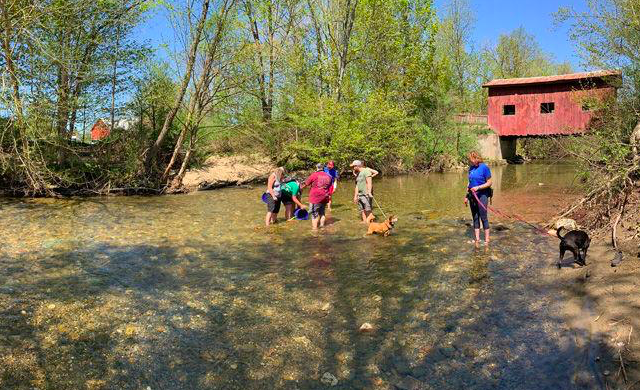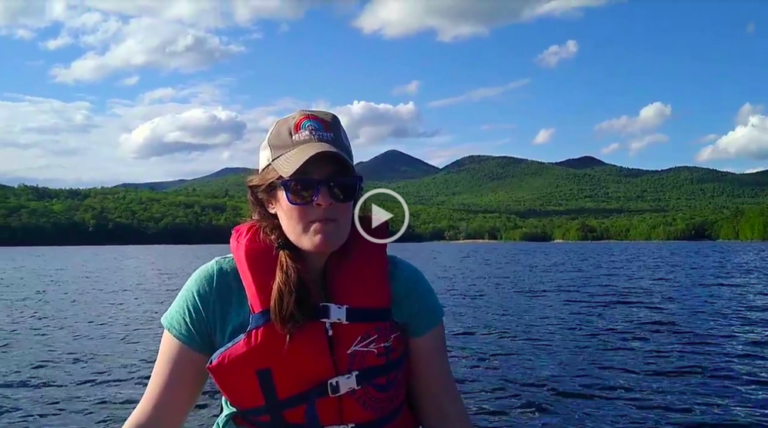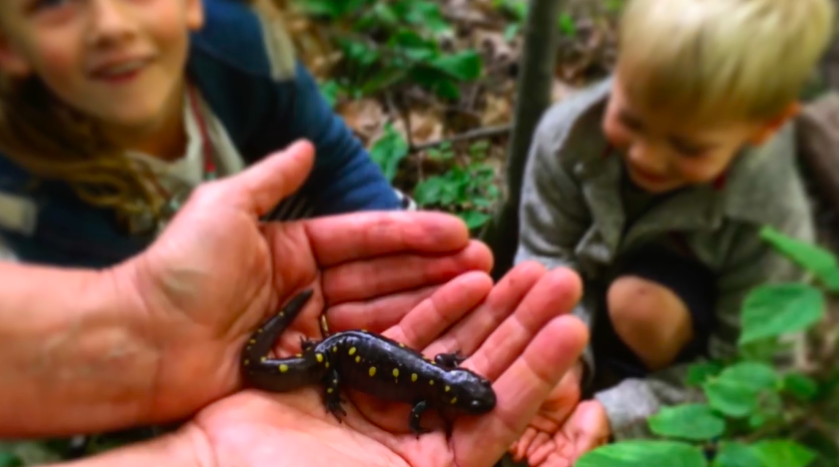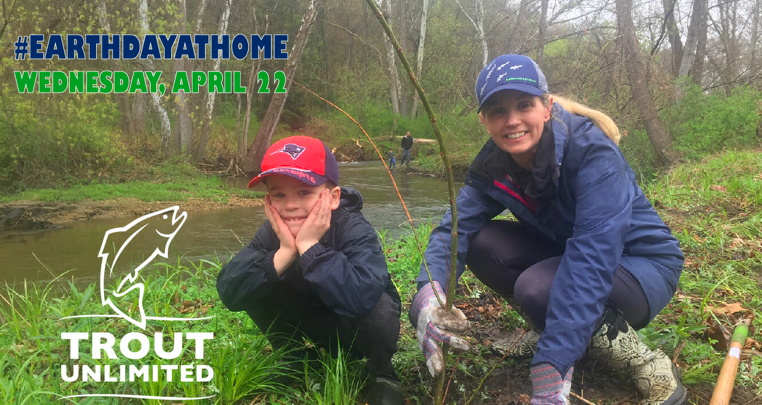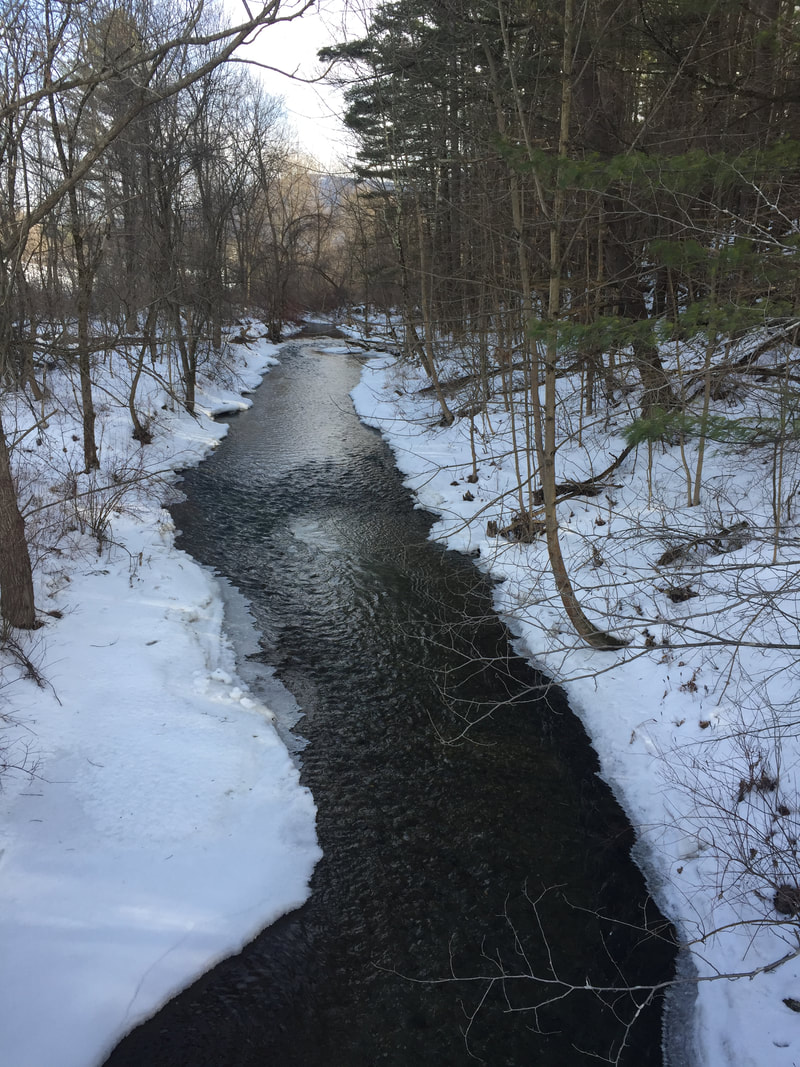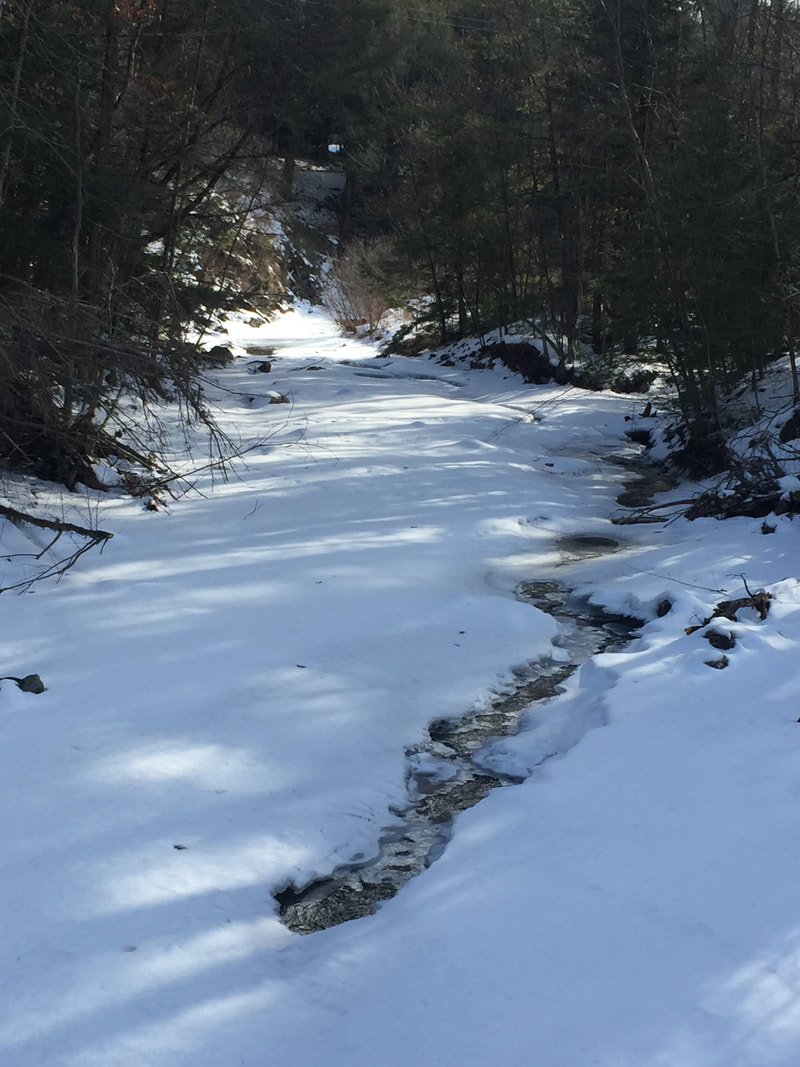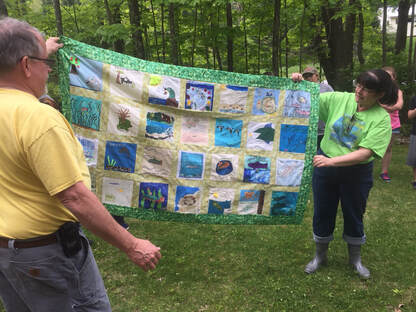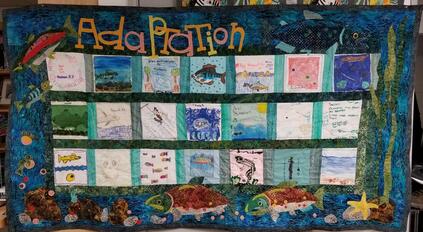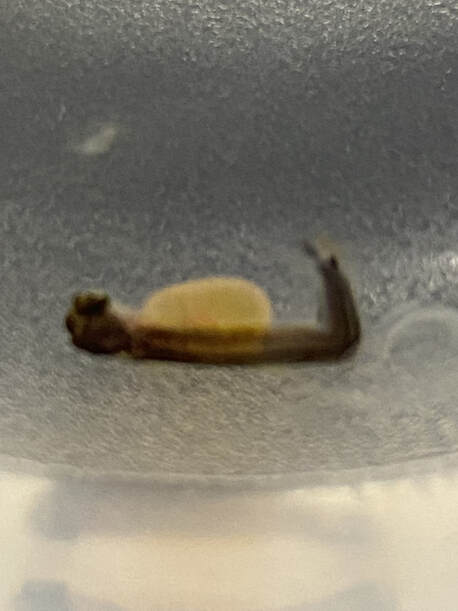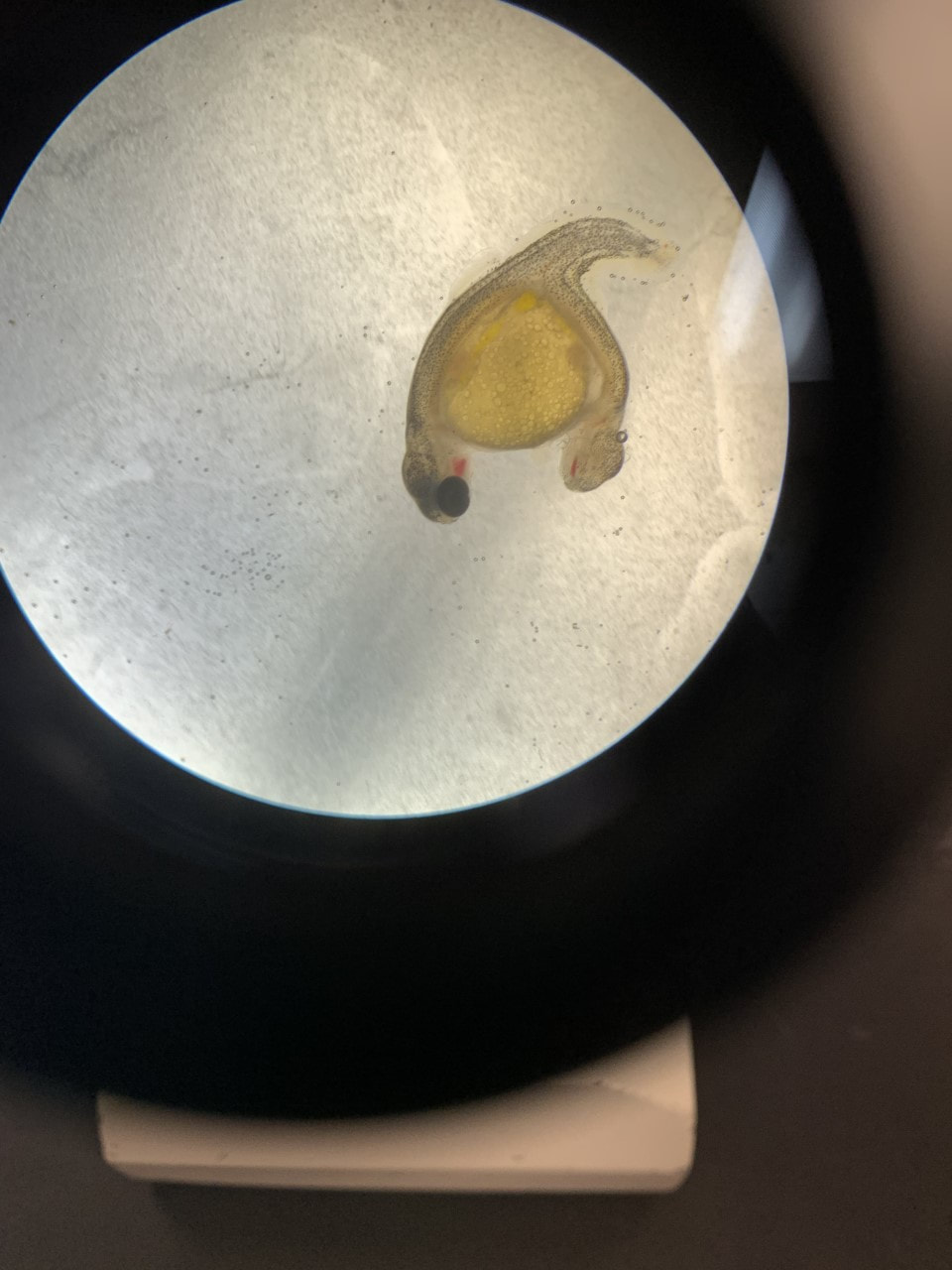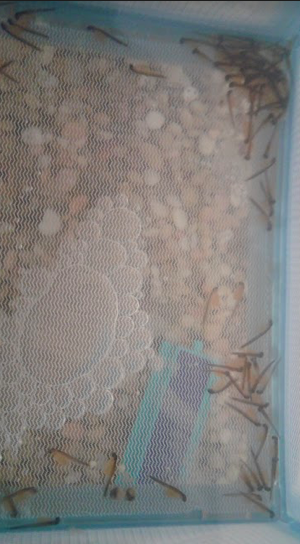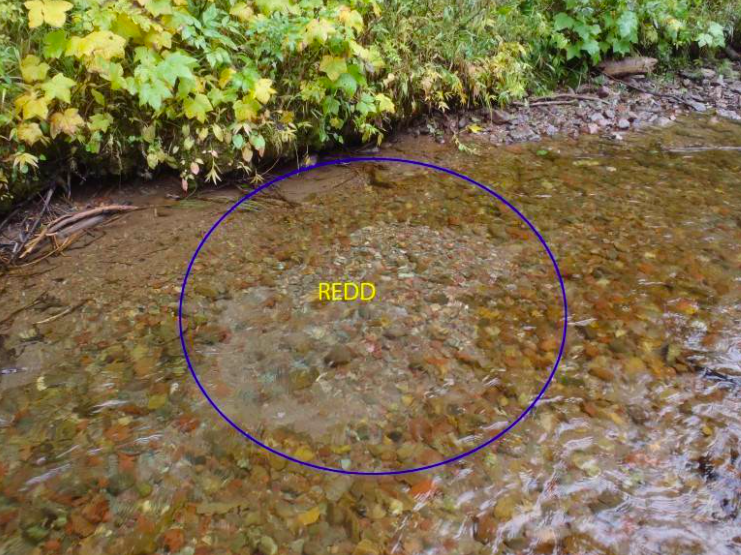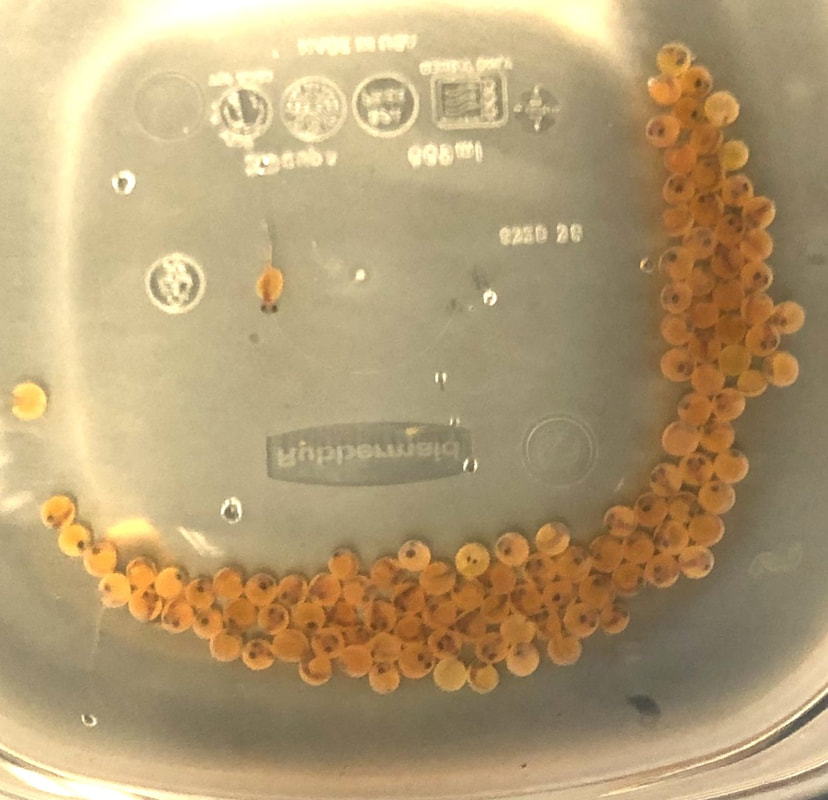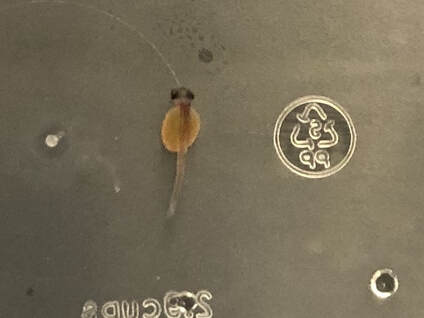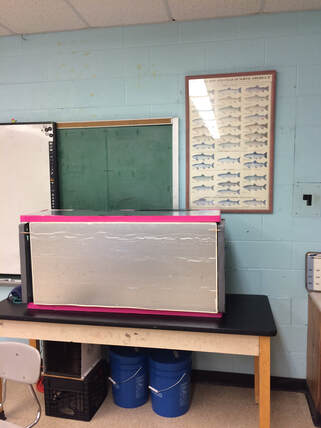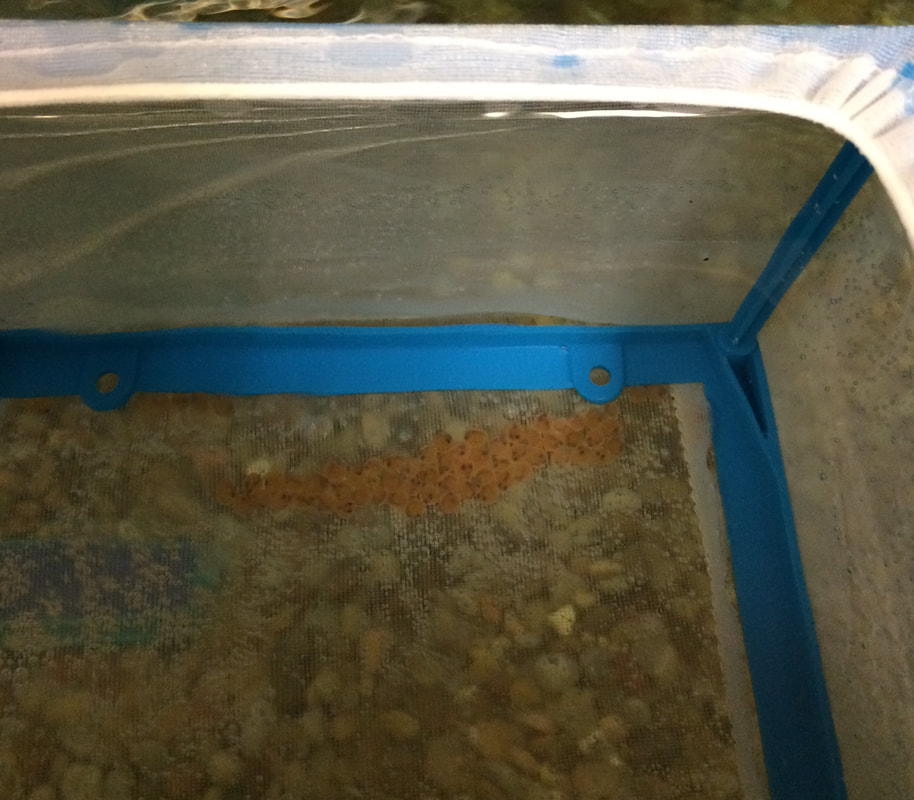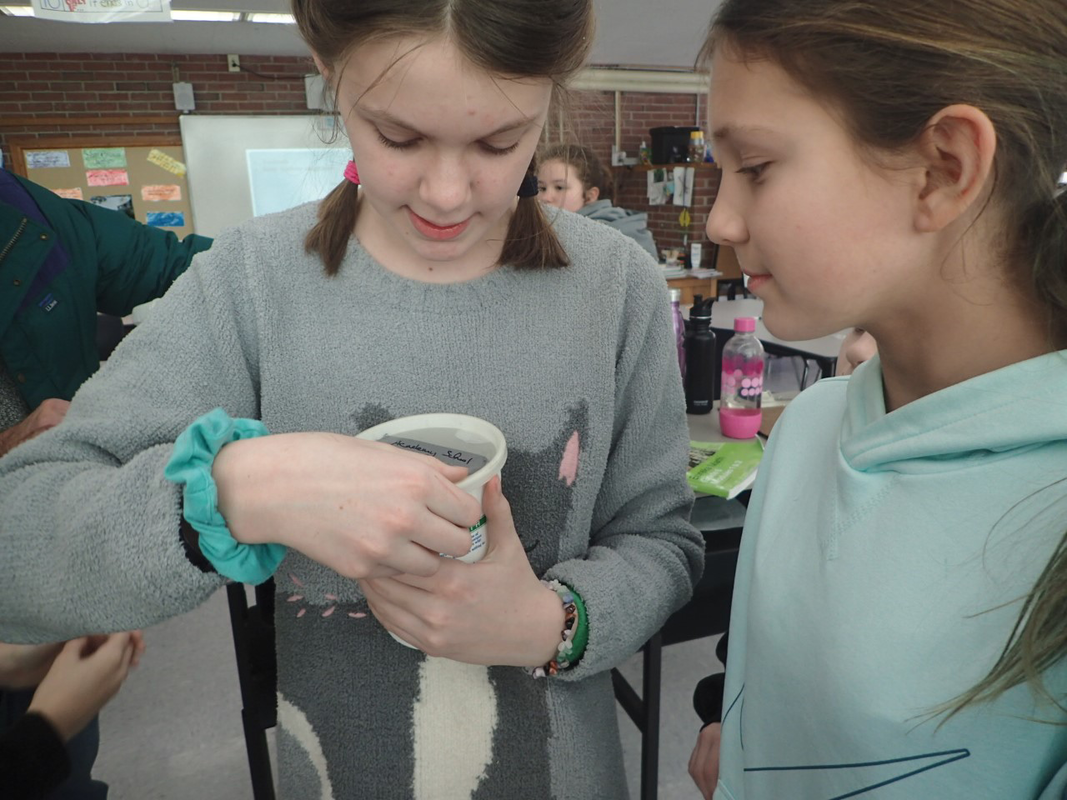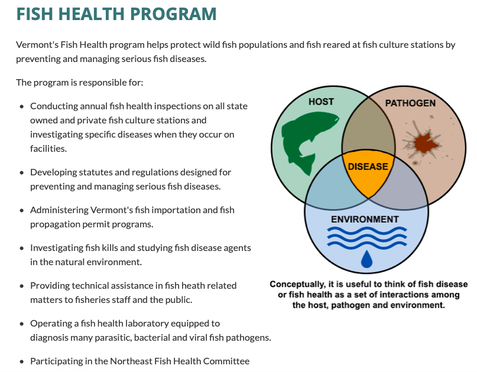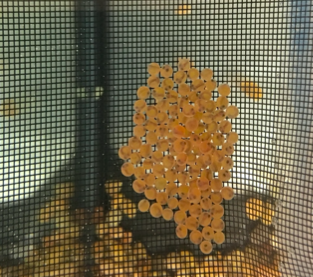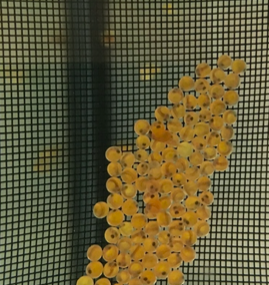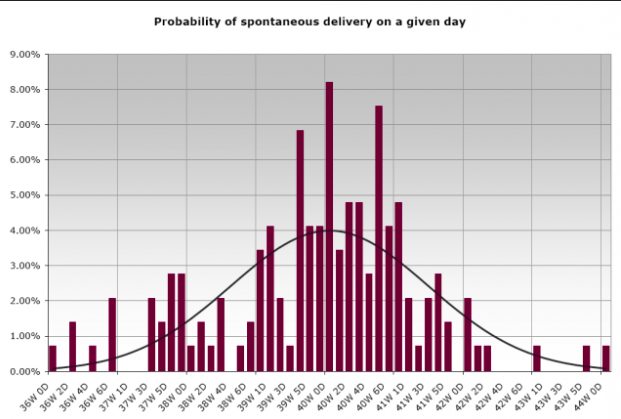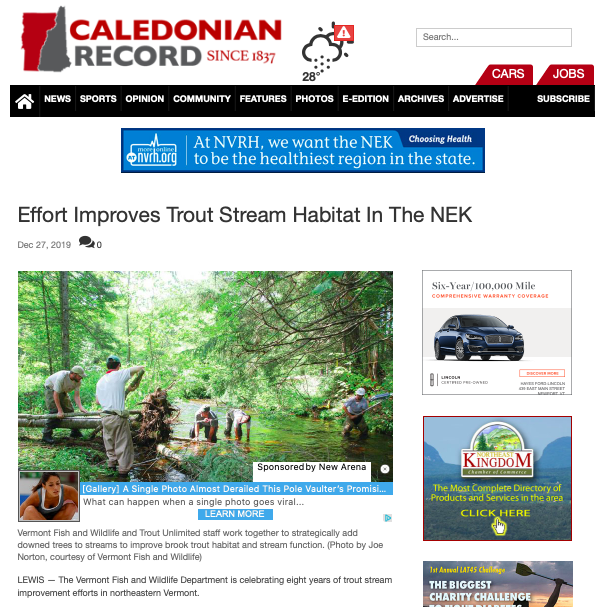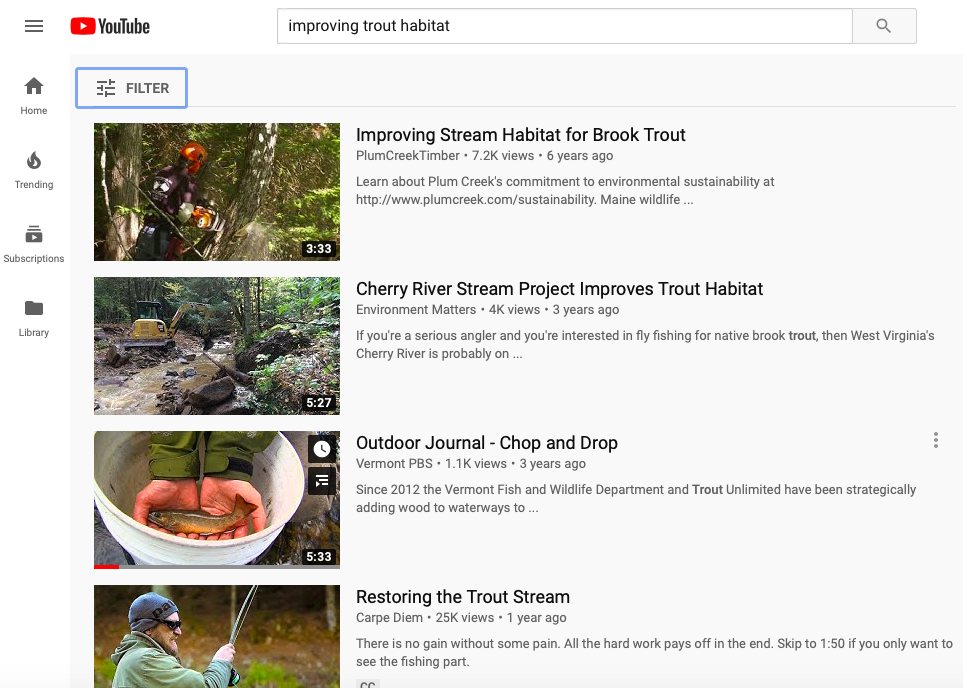TIC STREAMINGS
7/7/20
Milton Middle School publicity
Maureen Rowe Interview
After first-year TIC teacher Maureen Rowe, of Stockbridge Central School, released her trout in Chittenden Reservoir, she was interviewed about the Trout in the Classroom program. Click on the image below to watch the interview. Thanks for sharing, Maureen!
TIC Heroes!!
This year many TIC schools relied heavily on the unplanned services of lots of their colleagues. With the abrupt cancellation of school in mid-March, teachers had to scramble to come up with a plan for how to end the 2019-2020 program.
Some decided to release their trout right then. Others were allowed access to their classrooms and continued to care for the fry. Quite a few took their fish home with them and either moved the classroom tank or found a smaller tank to use. But a large number of teachers recruited school-based helpers–custodians, secretaries, food service personnel, even principals–to maintain the tank in their absence.
Those volunteers made a major positive contribution to this year’s TIC programs. Because of their generosity, numerous schools were able to keep their tanks going and keep their kids involved in TIC for as much as three additional months. And, in a number of cases, the custodian actually released the fish and documented it.
THANK YOU PEOPLE. THANK YOU HEROES!!
(Move your cursor over the images below to see the name(s) and school where those individuals work.)
[slideshow_deploy id=’735′]
Good-bye for now
This will be my last blog post for the 2019-2020 TIC year. I am so grateful to all of you for putting so much time, energy, heart, and creativity into Vermont’s Trout in the Classroom program. I’m convinced there’s a special place in Heaven for TIC teachers and volunteers.
This became such a strange year because of the novel corona virus, but you still made it work.
Thank you, thank you!
Have a good summer and stay in touch.
6/10/20
Hope Yeager’s release
Here’s what Hope Yeager, at South Royalton Elementary School, wrote on June 1:
I brought our classroom trout and tank home when our school closed on March 16. Last week I released the remaining trout into the stream near my home. Here is the video I made for my students:
Maple Street School’s release
Here’s what Suzanne Alfano, of Maple Street School, wrote the next day:
Hi Joe-
Hi Joe!
5/31/20
Amy Clapp’s “Naturally Literate” presentation on painted turtles
Several years ago Salisbury Community School’s Amy Clapp created a wonderful little booklet called Naturally Literate, which inventoried the most common flora and fauna that her students are likely to find in Vermont. (The booklet’s title is a link to its Web page.) She uses it to motivate her students to try to find as many species as they can and encourages them to record they discoveries.
During this time of COVID-19, Amy also produces short videos about entries in the booklet. Here’s one of her recent videos, this on the topic of painted turtles. Click on the image below to watch the video.
This link will tell you about how Amy created the booklet, how it’s designed to be used, and how you can obtain copies for your students for a mere $2 a piece.
Castleton Village School Nature News
Here’s Guy Merolle‘s latest weekly review of what’s happening in nature for his Castleton Village School students. This week’s Nature News reports on frogs, rat snakes, turtles, geese, birds, fish, and more.
Ferrisburgh Elementary School release
Bob Wible send me some great media documenting the Ferrisburgh Elementary School release of their healthy brook trout into a nice stretch of Lewis Creek. Congratulations, teacher Judy Elson and community volunteer Tim Davis! (Click on the image below to enjoy 14 short videos of the release event.)
Artifishal, the documentary
5/18/20
Castleton Village School Nature News
Here’s Guy Merolle‘s latest weekly review of what’s happening in nature for his Castleton Village School students. This week’s Nature News reports on many local wildflowers as well as lots of invasive species. There are a couple of garter snakes featured as well as a “blister bug.” Apparently we should avoid those. This video also includes another of Guy’s cooking demonstrations. My favorite part is when his two young sons eat what he’s prepared. Enjoy!
Essex High School release
Kelly Hill, science teacher at Essex High School, sent me this report and video of their release.
Hi Joe,
Williston Central School release
Colleen O’Brien and Aron Merrill, of Williston Central School, release their fry into Lewis Creek on May 14.
Here’s a link to a Google Drive resident slideshow related to the release. I hope you can access it.
5/6/20
Castleton Village School Nature News
Guy Merolle continues to crank out his weekly video reports on what’s happening in nature for his Castleton Village School students. Here’s his Nature News for last week. Make sure you watch the cooking demonstration Guy puts on at the end of the video.
Here’s Guy’s latest. It includes a theme song written by one of his students.
Orwell Village School lone survivor
Liz Volpe, of Orwell Village School, sent me this report.
I am thrilled to report that after an emotionally turbulent first time through the TIC program, thanks solely to the tireless efforts of Eoin Noonan, there is one remaining trout. I am including a picture. I went to school to clean out lockers today and there it was, alone but thriving, a quarantine champion!!!When do we release, and where is the best water near the Orwell Village School?
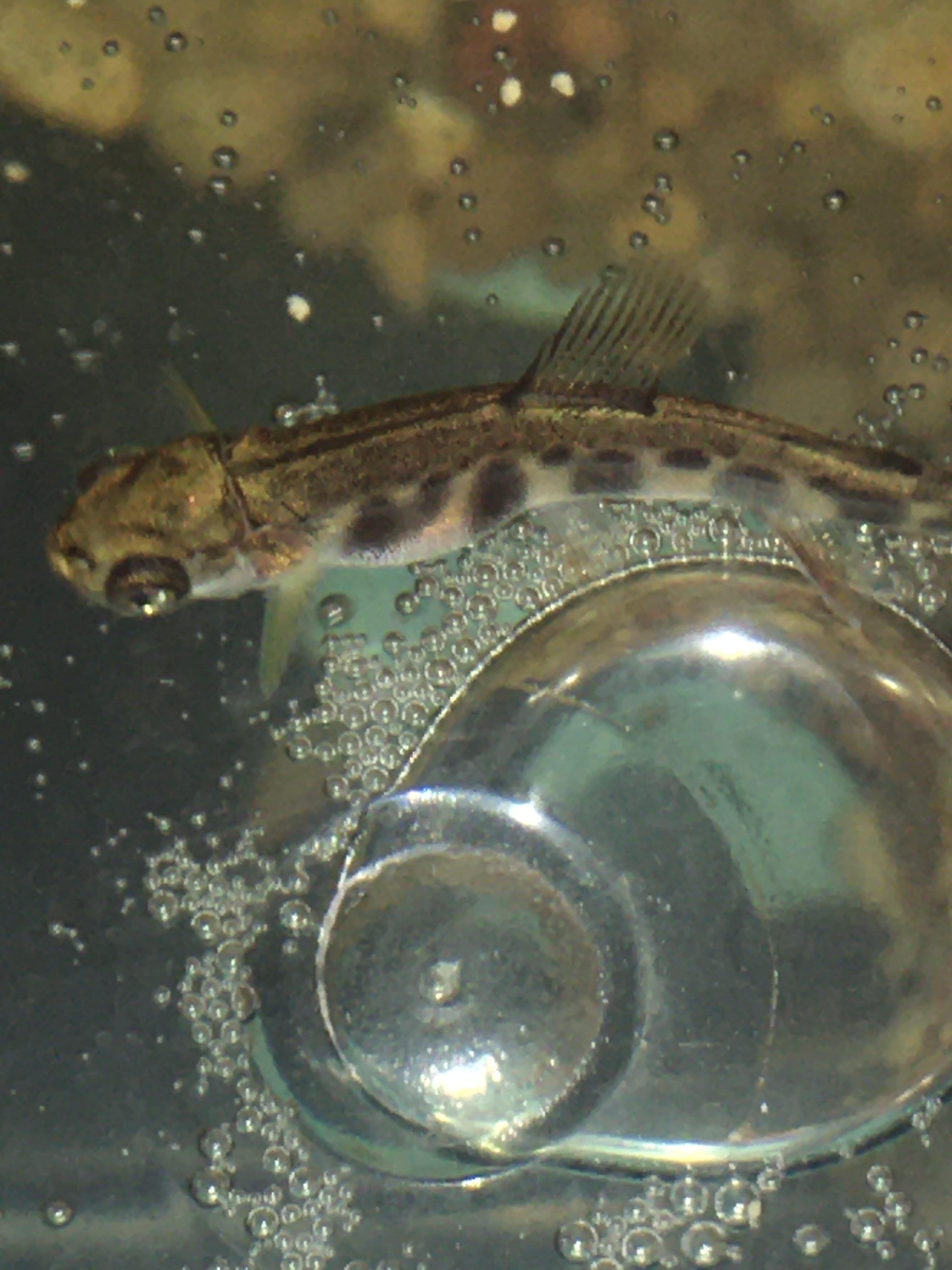
Our BFA Fairfax brook trout continue to do well under the care of a dedicated and caring custodian.One of my students got out and did some water and healthy ecosystem testing at the release site today and sent along some pictures. The temperature seems a bit high but it was great to have a student being involved. We hope to release next week when the overnight temps are a bit warmer. The tank temp has been lowered to its current 45 degrees over the last 4 weeks. Thanks for all of your support!
4/21/20
Cambridge Elementary and Founders Memorial joint release
Colleen and Paul Legris, she of Founders Memorial School and he of Cambridge Elementary, combined their fry in a tank at Paul’s school. On April 11, they released their fry–perhaps as many as 250 of them!–into the Brewster River.
Celebrate Earth Day!
Tomorrow is Earth Day, and an unusual one it will be. Nonetheless, I think in our own ways, we should all get out there and find a way to commemorate this important community event. Trout Unlimited is encouraging us to make the most fit. If you click on the image below, it will take you to a page with a number of suggestions. These include a Kids Earth Day Art Contest and ideas for a TU Family Field Trip. There’s a longer list of activities here
Riverside Middle School TIC Release Essays
Joseph Frigo, science teacher at Riverside Middle School in Springfield, sent me these essays his students wrote. I thought the students did a nice job.
Student Essay 1
My class and I have had trout in our classroom. We had kept them in a tank, and had been studying them. We’ve lined up the different stages of trout, and I learned why culverts are bad for them. They are bad because they prevent the fish from going to a safe passage sometimes. After learning some things about them, unfortunately we had to let them go early, because my teacher wouldn’t be able to take care of them due to this sickness canceling school. So, when he let them go, our class took a vote on whether or not they would survive after being let go so early. Here’s my opinion.
I voted that they would not survive, because they are small, and could easily be bait, and the surface temperature of the water could get too warm. Also, the water might not be clean enough, and there may not be enough things to eat. They were very small when we let them go, so they might not even be ready to go by themselves. They have some reasons why they would live, but I feel like there are a lot more reasons why they won’t.
In the end, I always thought of fish to be natural in the water, but I now realize that a lot of fish aren’t ready to be on their own that quickly. They need more time to grow, and learn. This project also made me realize that one reason they might not survive is because the water isn’t clean enough, and that means that the water really isn’t that clean at all if fish can’t live in it. I always knew about how some water could be bad, but I didn’t realize that ours could be too. I think that in the future, we should try and take care of our water for the fish, and if we get anymore of them, we definitely should try to keep them longer so they have a better chance at surviving.
Student Essay 2
Will the trout survive? Before we left school we had a tank full of trout in science class. We were going to raise the trout then set them free in the black river behind school. Due to our current situation the trout had to be set free early. I want to be optimistic and say that they are going to survive but after some research I found that it is likely they won’t.
According to my research most stocked trout don’t survive past one week in streams. To test this Biologists released 492 trout with radio transmitters and over 60% of the trout didn’t survive in the streams. With this information I’m going to assume due to the facts and how small the trout were when they had been released that they did not survive either. Another example I have is that stocked trout will remain in the area they were stocked at for a number of days. We were raising brook trout. Brook trout have been known to stay in that area for up to 10 days. This makes the fish we released at high risk for predators like racoons, fish eating birds, river otters, and larger fish.
I think that it is crazy to think about all of the things people do to raise trout and it’s likely most won’t even survive. I had hope for the trout but sometimes I guess things don’t always work out the way you’d hope they would. I would want to try this experiment again another time to see how far we can get.
Student Essay 3
In science class we got brook trout as eggs so that we could raise them from eggs to full grown trout. Our goal was to release them into the Black River. Our plans got changed because of the COVID-19 so Mr. Frigo had to release the trout early. We could not leave the trout alone in the building because we still needed to take care of them by feeding them and checking the water.
In my opinion, I think that some of our trout will survive for a few different reasons. One reason I think they will survive is because trout can get really big and do not have many predators in the Black River. The environment in the Black River has a lot of places where trout can hide and be safe. Rocks, grass, and other things in the river give the trout a place to hide. This will also help them to avoid getting eaten. Another reason I think the trout will survive is because of their color. The green color helps them avoid being seen by birds like hawks and eagles. These are some of the reasons why I think our trout will survive.
In conclusion, this made me want to learn more about trout. At first I was not that interested in trout but as I saw them grow in our tank I became more interested. I now look in the rivers I walk by to see if I can find a really big trout. This also made me think about the Black River since I’ve grown up near it for most of my life. I hope that the river will stay clean enough so that I might be able to see one of our trout get big in the future!
Student Essay 4
In class we were learning about the different stages that trout go through. We would check on them and see how big they would get each week. They were in a big tank that was always at the right temperature or they would have died. The tank had rock on the bottom, and there were foam walls so it was nice and dark. We ended up bringing them to the Black River early because we aren’t going to school for a while. They would’ve died if we left them at the school, because we wouldn’t be there to feed them, check on them or even check the temperature of the water.
In my opinion, I think they have a 50/50 chance of surviving in the Black River. Trout need food, water, air and a place to live/hover in. I think they have a good chance of surviving because the color of them can blend in so nothing can take it. This camouflage will also help them find food. Also, they are small in size, but that is both good and bad. On the good side they are small so they can hide better. On the bad side, they are small and look like bait and birds or other fish may think they are food. I don’t think they were big enough to let go because they were still in the fry stage so they were still young and too small. They were not fully developed yet. Another problem is the pollution can kill them if it’s that bad. I have seen tires, bike pieces and even garbage in the river. I am surprised that you can see in the water!
This assignment has got me thinking about trout and their habitat. My biggest worry for the trout is dying from so much pollution. We could be more conscious of trash and objects in/near rivers considering wildlife like trout. We should stop littering and try to throw it away. Also, keep trash and unwanted objects away from rivers and wildlife. We should sustain their habitat to keep them (and all water life) alive and healthy because they are a part of this environment and our world.
Custodians are our heroes!
Danielle Ligouri, of West Rutland School, send me this selfie of Carl Serrani, whom she describes as “the awesome custodian who is looking after our fish.” (You can tell it’s a selfie because the logos on Carl’s clothing are reversed.) If your program got or has been getting support from a custodian, maintenance worker, school secretary, principal, food service worker, or other colleague, I would love it if you could sent me a photo of that individual or those individuals.

4/8/20
Guy Merolle‘s weekly science videos
Three of us had a small Zoom meeting on Monday. Maureen Rowe, of Stockbridge Central School, and Guy Merolle, of Castleton Village School. Maureen is one of those teachers who had brought her tank home, and it sat in the background during our videoconference. Guy had released his fish, and I included the videos he shared with me in the 3/30/20 blog I wrote.
After talking about the TIC season and, for most, its abrupt end, we switched to the general topic of COVID-19 teaching, that is, distance learning. One of the interesting things that Guy’s been doing is putting together each week and sending to his students a recording that Guy calls his “phenology report.” I had to look up “phenology.” Here’s how Wikipedia defines it: “The study of cyclic and seasonal natural phenomena, especially in relation to climate and plant and animal life.”
Here’s his report for 3/23/20.
Here’s the 3/30 Phenology Report.
Finally, here’s the video Guy sent his students this past Monday. Among other things, you’ll notice that he includes a lot of student work in his videos and occasionally speaks of a “contest” that he’s running. I wonder what that’s about.
Maureen Rowe’s blog
In some e-mail correspondence we had, I learned that Maureen Rowe was maintaining a blog. She uses this to keep her students updated on the trout tank she’s brought home. If you click on the image below, it should take you to Maureen’s live site. Check it out.
Devin Schrock‘s students’ projects
Devin Schrock, 5th and 6th grade teacher at Lincoln Community School, sent me this report on an interesting student project. Here’s how he described it.
Hi Joe,
- I can explain how photosynthesis impacts the flow of energy into and out of organisms.
- I can develop a model to describe the movement of matter among plants, animals, decomposers, and the environment.
- I can use a model to describe how energy in animals’ food was once energy from the sun.
Here are a few of the videos.
Devin also sent me instructions for the assignment. Here they are. (Click on the image to access the instructions.)
Thanks so much, Devin!
Rutland Town School release
Colby Hescock, 5th grade math and science teacher at Rutland Town School, This first video was shot in the classroom, where Colby talks to his students about what he’s going to be doing.
Colby and his colleague explain the site on East Creek where they’ll release the trout.
Finally they let them go.
4/3/20
Vernal pools
On a walk with my friend, neighbor, and former Rutland HS science teacher Tim Gilbert two days ago, we encountered the cacophonous sound of a marsh full of spring peepers, but it could also have been a pond or a vernal pool. Here’s a recording I made with my iPhone. What do you hear?
I’m not an expert, but I think I can detect at least three different species. What are they? Can you use this activity with your students? They’d have to be under the supervision of a responsible adult, but this is the perfect time of year for them to be looking for the signs and sounds of early-spring life. Perhaps the kids could make their own recordings and share them with you and the other students, asking them to identify the species by sound. Worst case, you could find sound of nature in the Internet and challenge your students to make the identification.
I know many schools investigate vernal pools at this time of year, and, while I hope you never find a brook trout in a body of water so ephemeral, the study of vernal pools is a great way to keep students engaged in nature at a time when “social distancing” has become necessary. Below is an activity page (designed for young learners) that focuses on peepers. The image is a link to the Web site.
If you’re interested in getting your students into the topic of vernal pools, you’ll find numerous resources available online. Her’e just one example of what’s out there. It’s provided by the University of Maine cooperative extension center. (Click on the image below to go to the Website.)
Trout out of the Classroom
At least 15 Vermont TIC teachers invited their trout to come home with them during prolonged school closure necessitated by the novel Coronavirus. Here’s a video shot by Suzanne Alfano, of Maple Street School. In transmitting this to me, Suzanne acknowledged that the filter intake was unprotected by mesh. She immediately addressed that.
Sabrina McDonough, of Shrewsbury Mountain School, also sent me a video of her relocated trout. They look pretty good, don’t they?
Like Joseph Frigo, Karli Love, of the Dorset School, recorded three videos of the stages of the process of releasing her class’s trout into the Mettawee River. Here they are.
3/30/2020
We live in interesting times!
Have you been wondering why I haven’t been bugging you? There’s an explanation for that. My Weebly.com account hit a wall. The last time I attempted to write a new blog post, I found weird things happening with my inserted photos and slideshows. Using the free version of the platform, I was never able to get an answer to my question “What’s going on?!” My best guess is that I had reached Weebly’s limit of 500 mb of uploaded files, which applies to those using the free version.
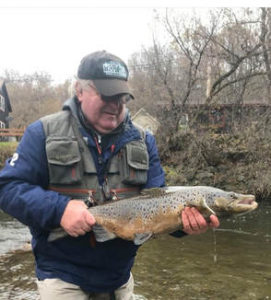 In any event, thanks to the extraordinary volunteer efforts of Mad Dog Trout Unlimited member Ian Sweet, I am back at it. (That’s Ian to the left, with a beautiful Clyde River landlocked salmon he caught.) Ian offered to transfer much of our old Weebly web site to the Vermont Trout Unlimited State Council Web site.
In any event, thanks to the extraordinary volunteer efforts of Mad Dog Trout Unlimited member Ian Sweet, I am back at it. (That’s Ian to the left, with a beautiful Clyde River landlocked salmon he caught.) Ian offered to transfer much of our old Weebly web site to the Vermont Trout Unlimited State Council Web site.
He and I are working together on doing that, but it’s going to take a while. At this point, the old Weebly VTTIC site is perfectly functional. You just won’t find any new blog posts there or for that matter any other additions/changes to the site. Gradually, the VTUSC site will begin to hold all or almost all the content of the Weebly site. At that point, we will keep both sites going for a couple of months. Once we’re confident we’ve migrated just about everything and everybody to the new VTUSC site, we’ll take down the Weebly site. For now, the quickest way to access the TIC blog is at this URL https://www.vttucouncil.org/?page_id=335
So, how are schools coping with the pandemic? Some have up until now been gaining access to their trout at school and caring for them. But given Governor Scott’s announcement on 3/25, I believe that option is off the table except possibly if a TIC school that’s educating/providing childcare for the children of “essential workers” and if either the TIC teacher is involved in that programming or someone else at that school who is (the principal?) is willing to tend the tank and its fish.
Some teachers have released their trout, and I anticipate that others will be doing so shortly. There’s a high probability that our still-young and weak fry won’t have much chance of surviving, especially if there was a sizable difference–five degrees or more–between the tank water temperature and the temperature of the release stream.
Several teachers took their trout home, either setting up the classroom’s tank or moving the fish to a second tank that the teacher procured. In a small number of cases, TIC teachers in the same area collaborated, allowing two or more teachers to have their respective fry bunk together. In some instances, colleagues or friends offered to host the tank. All around, a lot of piscine generosity and willingness to put in extra effort was displayed.
ONE DAY REPORT!
The chair of Vermont Trout Unlimited’s State Council called a meeting for the evening of March 26, with “TIC update” on the agenda. That morning I sent an e-mail to the teachers at our 99 TIC schools, asking for a status report. Amazingly, by 5:30 that day, I had heard back from 67 schools. Fantastic response, huh?! The summary:
- 14 teachers had brought their trout home, with a number of others contemplating doing the same;
- 19 schools had released their trout; and
- 34 schools still had their fry in the classroom. Many of this last group were getting terrific support from generous and dedicated colleagues: custodians, school maintenance staff, and principals.
Here’s a link to a PDF document that provides the details. (Black text represents schools that had already released on 3/26/20; green text signifies schools that still have their trout in the classroom; blue text is for those teachers who have brought the tank and fish home with them.)
Colleen Legris, of Founders Memorial School, gave her fry to husband Paul Legris, of Cambridge Elementary School, and Paul put Colleen’s fish into his CES tank.
Joseph Frigo, of Riverside Middle School, sent me these three videos in which he talks to his students as he ends their TIC program early by releasing their fry into the Black River.
Guy Merolle, STEM teacher at Castleton Village School, shared two videos of him releasing CVS’s trout.
Hanna Galinat, of the Riverside School (a different one), was one of those teachers who brought her trout home and sent me this nice report.
I brought my trout home where my own kids are loving them. I have slacked off with recording the water chemistry data, though I’m still checking it. They are all swimming around free. When we still were in school, we were having a great time doing some of the lessons on trout anatomy, doing some stream monitoring, playing a life cycle game, drawing fish tessalations, learning about the water cycle, sketching Trout in the Classroom quilt squares, and doing math problems related to the area and perimeter of the quilt. I still plan to mail my students the fabric and their sketches so they can make their quilt square final drafts. If school remains closed for the rest of the year, I’ll live stream a release of the trout into our neighbor’s pond (flows into a brook that flows through our farm, into the Stevens River and then Connecticut). Then in the fall, I’ll invite my old students (along with my new students) out to that pond for a fishing field trip/ tour of our farm as a kick off for a new year of TIC.
Rivers and wood
Have you ever read the book Trout Are Made of Trees? It’s delightful; and even though it’s been written for young readers, the science behind it is quite sound.
Well, I had the theme of that book in mind when I went down to the nearby Castleton River this weekend. It is blessed with lots of “woody debris,” and that’s good for the trout. It was also a modest 40 degrees Fahrenheit. Here are some pictures of the Castleton.
[slideshow_deploy id=’574′]
On the “wood is good” theme, I also found this great article, which focuses on the importance of wood in Vermont brook trout streams: Wood is good for Vermont brook trout.
Here’s the photo they hooked me with.
TU Family Field Trip: Streamside scavenger hunt
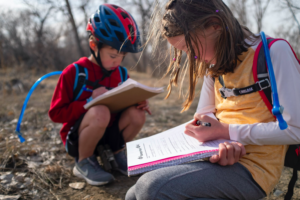 Trout Unlimited’s national office often sends me interesting ideas and information. Here’s another one of those communiques. It’s suggestions for a stream side scavenger hunt.
Trout Unlimited’s national office often sends me interesting ideas and information. Here’s another one of those communiques. It’s suggestions for a stream side scavenger hunt.
You might do one of these with members of your own family or you might suggest that, with proper adult supervision, your students conduct a scavenger hunt and report back to you. (Click the photo or the underlined link above to read the story.)

EPSCOR offers options
Veronica Sosa-Gonzalez, Coordinator at VT EPSCoR, asked me to pass on two ideas you could explore with your students, especially during this prolonged period when you’ll be trying to facilitate their learning from afar. Here’s the first:
I’m excited to announce the launch of the website, www.cleanwaterwork.com, featuring all eleven videos and three educational animations highlighting local success stories and meaningful efforts to improve local water quality! There is hopefully a story for everyone to connect with and learn from!
We hope people will incorporate these videos into email updates, social media posts, newsletters, websites and however they reach their specific networks, colleagues, and friends. Given the broad school closures and higher demand for online content, I’m hoping to get these out to as many teachers as possible.
I truly hope this video series helps further the mission of your organization as well as educates and engages the general public in what can be done.
Best,
Vince Franke, Peregrine Productions
Here’s Veronica’s second suggestion:
We are hoping this is a helpful resource now that schools are shifting to remote learning. Another great resource for remote learning on the same topic is the Saving Our Waters curriculum that VT EPSCoR and VT PBS jointly worked on. Teachers can find classroom materials and resources here: https://www.vermontpbs.org/water/curriculum/
Stay well and keep in touch!
Joe
__________________________________________________________
3/14/2020
UPDATE: COVID-19 preparedness. Trout Camp. Photos and videos. Reports from the field.
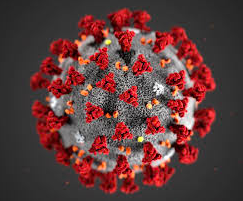 COVID-19. What should you do to be prepared?
COVID-19. What should you do to be prepared?Do you know anybody who’s not talking about the Novel Corona virus? I don’t. But what does it mean for schools in the TIC program? Two things really: (1) making sure that concern over the infection doesn’t lead to toxic substances getting into your tank and (2) being prepared in the event that your school is closed because of the disease.
No spraying! Some schools are quite eager to spray disinfectants in classrooms when there’s widespread risk of infection. Spraying would almost certainly be disastrous for your trout. Please proactively speak to anyone who might be involved in such a project, or in authorizing it, and beg them to skip your classroom. Since every school that I know of has an integrated, building-wide air-handling system, even if you succeed in convincing the “powers that be” not to spray in your classroom, your fish could still be fatally impacted by spraying elsewhere in the school. For this reason, you should be prepared to cover your tank with a blanket when and if you anticipate that there will be spraying in the building. The foam insulation alone will probably not protect your trout. The same goes for wiping classroom surfaces. Keep that practice away from your tank too!
Several Vermont colleges have already announced that they’re closing, perhaps for the rest of the academic year. A few schools have also decided to do that but only for a few days. It’s conceivable that many Vermont schools could close for days or weeks or longer.
Good afternoon, In the event of a building closure due to the spread of COVID-19, what are your plans for your trout program?
You can always count on Maryland TIC coordinator Chuck Dinkel for a response. In this case:
Juliette, you could move the trout to a 5-gallon bucket with an aerator and frozen bottle of water, drain your tank, and have someone from school help you move it to your home or some other location where it could be set up and run again. Being an ex-New Yorker and your being in Manhattan, that may be easier said than done. Tanks are not something you’d want to move via the subway.
Another respondent, Zachary Houle, of Taconic High School in Pittsfield, told us what his district is going to do:
We have a plan where one of the teachers is going to take them home if we close. She’s already brought a big tank home and set it up and will bring one of our chillers the day of, if needed.
Working together! Great idea, Zachary.
3. Is there a possibility that you and several other area teachers could collaborate and all take your fish to one off-campus tank?
Heather Weiss said:
I was just talking to my head of school about this. In the event of a closure, I’m going to release the trout on my own and live stream it.
I don’t know where Heather‘s school is and when they started raising their trout. (Some schools began this process early in the fall, and their trout are undoubtedly much larger than those in Vermont schools.) Given how small our fish are, I’d call this a worst case option for us.
4. Finally, if none of the options offered above will work for you and if your school is going to be shut down for an extended period, you may have to release your trout prematurely.
IF YOU DECIDE TO RELEASE YOUR TROUT, TWO SUGGESTIONS:
- TRY TO SYNCHRONIZE THE WATER TEMPERATURE OF YOUR TANK TO THAT OF A LOCAL STREAM. (You can drop the temperature three degrees in the morning and another three degrees at the end of the day. I assume that your local streams will be in the mid to high 30s. Minutes before posting this update, I checked the temperature of the Castleton River. It was 38 degrees.)
- YOU MAY HAVE TO FIND A SMALLER STREAM OR A STREAM AT HIGHER ALTITUDE THAN THE ONE WHERE YOU HAD INTENDED TO RELEASE YOUR TROUT. Our fish are small and, at this point, still relatively weak swimmers. At this time of year, many valley streams are high and turbulent. This evening, the Castleton River was close to flood stage. Our fry would likely be swept to Lake Champlain or the Connecticut River very quickly. (And die along the way.) Releasing your fish into a small tributary–even one that is just two or three feet wide might do–will give them a fighting chance.
Trout Camp
On a happier note, I want to bring the 10th annual Trout Camp sponsored by Vermont Trout Unlimited to your attention. Here’s an announcement that TU volunteer Doug Zehner sent me.
Begin a Lifetime of Fly Fishing and Learning at the Vermont Trout Camp — June 21-25
Trout Unlimited presents the 10th annual Vermont Trout Camp for teens at Jackson’s Lodge in Canaan, VT, June 21-25, 2020. Boys and girls age 13-16 interested in science, the out-of-doors, and learning to fly fish are invited to apply. The application deadline is April 15th. Details and an application are available at www.vermonttroutcamp.com
This is a marvelous opportunity for young people to experience the outdoors to the fullest. The camp program features instruction in basic and intermediate fly fishing skills (casting, knot tying, fly tying, fishing tactics), entomology, fish biology, conservation and cold water fisheries management and of course lots of time on the water fishing with knowledgeable guides. No experience is necessary, and all equipment is provided.
If you know of any young person who might be interested in attending camp, please encourage them to apply. Please visit the website for details about camp or email us at vermonttroutcamp@gmail.com with questions.
(The screenshot of the Trout Camp web site below is also a link to the site, so you can click on it.)

Trout video
Vasanthi Merette, of Shelburne Community School, sent me this video today. I though you might want to see what another school’s fry look like these days.
Thanks, Vasanthi!
TU volunteer Barry Mayer sent me these photos that he took while visiting Amy Newbold‘s tank at the Village School of North Bennington. Since Amy set up her tank in the school’s library, she’s taken some precautions to make sure guests don’t accidentally bump into the tank.
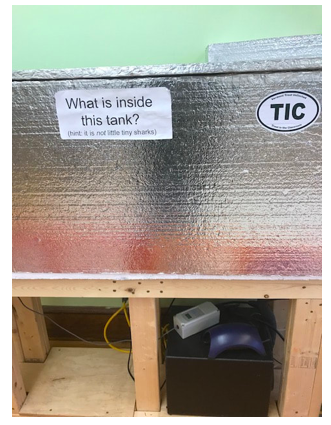
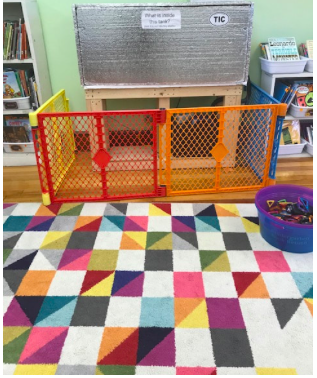
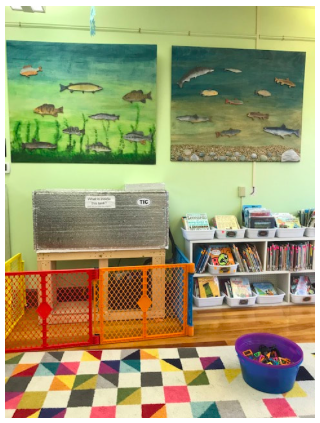
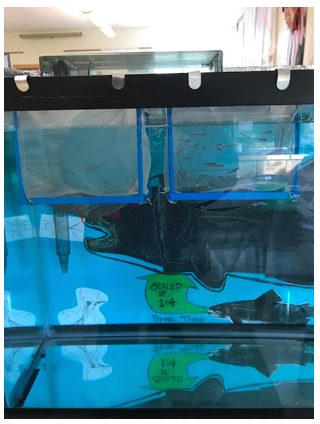
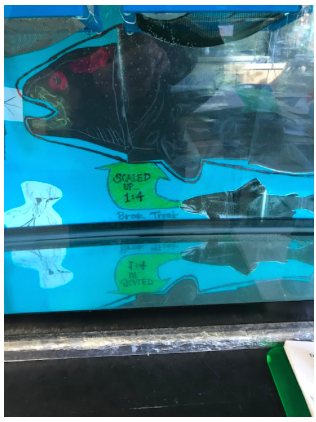
Riverside Middle School checks in
Joe Frigo, 7th grade science teacher at Riverside Middle School in Springfield, sent this report.
Nearly all of our trout are feeding and a few have escaped from the basket and are in the tank. They’ve proven to be hard to catch in order to put back in the basket! We are looking forward to releasing them from the breeder baskets sometime next week.
And he sent a couple of photos too. Thanks, Joe!
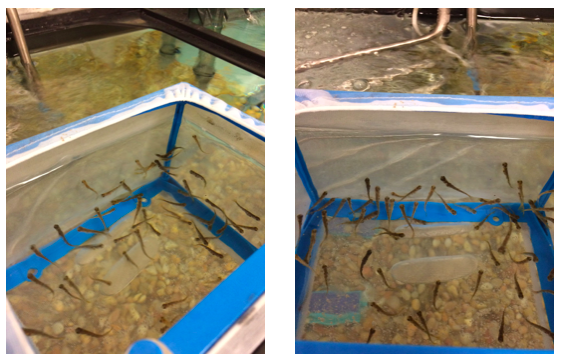
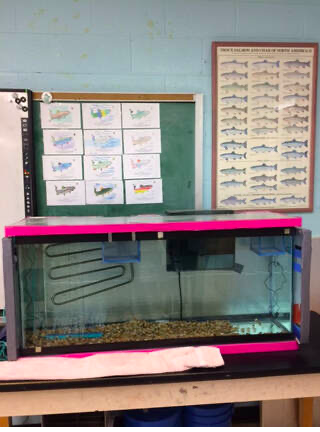 On Tuesday, Joe Frigo, of Riverside Middle School, sent this update on his school’s tank.Anticipating swim up this week! After a week at 46 degrees I’ve increased the water temperature by a degree and have begun taking the front cover off of the tank during the day. The increase in movement has been noticeable and I think swim up should happen in the next few days. Our current DI is 81.98 and growing! I tried to put in a little bit of food this morning and saw one or two alevine swim up!At right is a photo of Joe’s attractive tank set up.
On Tuesday, Joe Frigo, of Riverside Middle School, sent this update on his school’s tank.Anticipating swim up this week! After a week at 46 degrees I’ve increased the water temperature by a degree and have begun taking the front cover off of the tank during the day. The increase in movement has been noticeable and I think swim up should happen in the next few days. Our current DI is 81.98 and growing! I tried to put in a little bit of food this morning and saw one or two alevine swim up!At right is a photo of Joe’s attractive tank set up.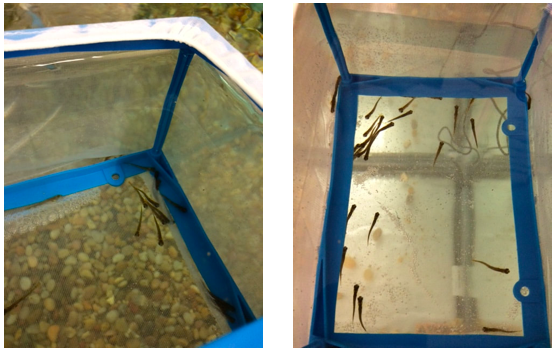
3/14/2020
Wonderful hallway trout sculptures at MSS!
Suzanne Alfano, 5th/6th Grade Science Teacher at The Maple Street School, sent me the following message:
Hi Joe-
Look what’s swimming down our halls at Maple Street thanks to the collaborative efforts of our art teacher Leslie Sullivan and whoever the TIC teacher was that shared the resource. Our 5th Graders loved this project and we will definitely be making it part our TIC curriculum every year.
Here are three photos Suzanne sent me. Cool, huh! How about those great shadows?
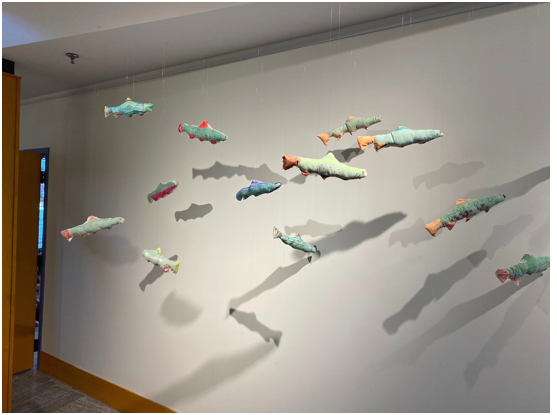

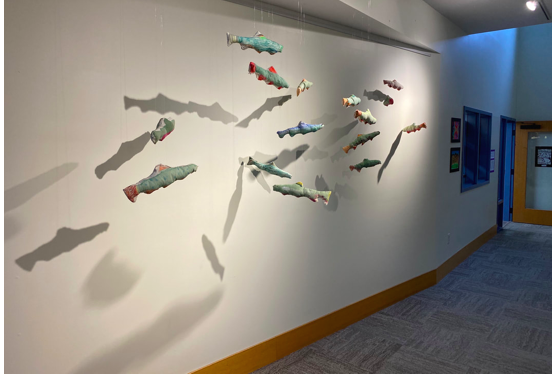
Documenting TIC at Newark Street School
Cindy Mosedale, first-year TIC teacher at Newark Street School, sent me a document she produced that describes their Trout in the Classroom program to date.
But first, a bit about Newark, Vermont, which I had to research and which I suspect may be the smallest and most remote Vermont town to host a TIC project. (If you think your town deserves that distinction, let me know.) With a maximum elevation of 1,319 feet, Newark lies on the northern edge of Caledonia County. It is south of Island Pond, southeast of Lake Willoughby, north of Burke, and is bordered by a large untracked region to the east. Its population was 581 in the 2010 census, with a density of 16 people per square mile. The history of its population growth and decline is interesting. In 1800 it had eight residents; by 1880 that had grown to 679. That all-time high was followed by a long period of continuous decline, which bottomed out in 1970 when there were only 144 people in Newark. Since then, growth has returned. By the way, Lowell, with a slightly larger population (738), is more sparsely settled than Newark (13.2 people per square mile). What do your kids know about your community and how it compares to others around the state?
Here’s a link to a list of all Vermont’s towns, including population data, area, etc. The town with the smallest population, by the way, is Lewis (Essex County) with no residents. Somerset (Windham County) has three, and Glastenbury (Bennington County) has eight.
Click here to see Cindy‘s document. And below are screenshots from Cindy’s document. Great work, Cindy!
The day after I posted the last blog, I got this good news from Keith Harrington, of Poultney Elementary School:Good Morning Joe,
After our breeder basket dumped all of our alevin into the tank, I have just been going about normal procedures. No need to panic. As I said to my students, “We have been very lucky over the years compared to some schools. Maybe this was just our time to not be lucky!”When I came back from Spring Break armed with a new small net to try to collect some alevin to put back in the breeder basket to make sure they were eating, I got a nice surprise. I caught two and put them in the basket. The next thing I know many were swimming up from the rocks to the top of the tank so I fed them. They attacked the food. So I Iet the other two back out to join their friends. More and more are swimming up every day. I am quite pleased. Looks like we have a nice group of survivors so far. I was also glad to see after being gone for a week that the water chemistry was good. Except for GH that was quite high, all readings were near perfect. That’s a great turn of events, Keith! I am very happy to hear it.
We get by with a little help from our friends!
Liz Volpe, of Orwell Village School, sent me a nice note that day too.I’d like to send a huge shout out to Eoin Noonan of Orwell Village School. He diligently fed the fry and checked chemical levels all week during the February break.All of the trout were alive and well upon my return. This was a very exciting way to start back to work.Can we give him some public recognition?Yes, we can! Thank you, Eoin!!When should you release your fry into the tank?
This morning, Joe Frigo, science teacher at Riverside Middle School, sent me this question:Most of my trout are feeding and swimming around the breeder basket. Do you think it is ok to put the basket in a position that allows the more adventurous trout to swim out into the tank?When I asked Joe when he started feeding his fish, he said last Friday. That prompted me to respond, “Keep them in the breeder basket for at least another week.” Releasing fry into the tank too soon can be a major cause of die-offs. We recommend that you keep them in the basket for at least two weeks after they’ve all been feeding.
Some teachers have reported that their fish have swum up and are eating. These are at classrooms that used the “warm and fast” temperature protocol. Most, schools, however, have kept their tanks cooler–perhaps 43 degrees or so–in order to have the swim-up occur after the winter break.As we’ve discussed both at the fall workshop and in previous blogs, the key to knowing when your fish are likely to swim up is tracking DI (Development Index). You do this by entering daily temperatures, including estimated temperatures over weekends and school breaks, in the spreadsheet titled “NEW 2019 Temp and DI record and swim-up calculator“ (using the Temp entry and DI record worksheet after you’ve opened the spreadsheet in Numbers). Even if you haven’t been keeping up this spreadsheet, as long as you’ve been recording temperature, you can reconstruct the Temp and DI record and find out what your DI is.So what DI are we looking for? The experiences of TIC teachers in the past suggest that a DI of 82 is the time to be hyper vigilant. We believe that most fry will start swimming up between DIs of 82 and 87.When your fry swim up, you should try feeding them a tiny bit of food. If the alevin don’t eat it fairly quickly, scoop it out and discard.Over the next couple of weeks, it will be critical that teachers and students whose fish haven’t yet swum up are watching their alevin/fry very carefully, looking for signs that the alevin are getting ready to swim up. Here’s a short video that tries to explain what that swim-up readiness looks like.
National TIC/SIC network discussions
I’m sure you recall that I participate in the TU national TIC/SIC network. Here Areva few extracts from recent exchanges on that network’s e-mail list serve.
Teacher Douglas Bell, of Lyons, Colorado, raised two issues in a recent e-mail to the group (BTW, Colorado’s TIC program starts much earlier in the fall): he reported inter-fish aggression resulting in casualties and wanted to know how many of his fish he should expect to carry through to their release day (they now have 70 in their 55-gallon tank).
Scott Hood from Oklahoma answered:
A good question … but one you will only answer when you are one your way to the release point.
Be delighted when you have 20. I got a text this morning from one of my schools … all trout dead. Seems the school janitorial staff had orders to spray the school with disinfectant for flu virus. In spite of signs to Please Do Not Spray in the area of the tank, they did it anyway! Very sad day for these students.
Doug replied in turn:
Oof, I’m sorry to hear that. We had a substitute cleaning staff turn off our power strip over the weekend when the fish were pretty small. They weathered it, but now we’re always on guard.
Scott, came back with:
Douglas, power failures due to weather or construction, accidental and not so accidental unplugs by helpful janitorial staff, and anti-bacterial soap on little hands that find there way into the water … number one killers.
However, we’ve had huge celebratory releases for as few as 3 surviving trout before with class of over 75 kids. Some have gone to the release area with zero. We always go.
Chuck Dinkel, my favorite TIC support person, contributed this:
A school in Maryland had the exact same result when their school was sprayed 4 times with a mist to control the flu virus. This was a first for us. If the teacher had had advanced warning of this would there have been some way of covering the tank to protect the fish?
So what’s the take-away from these conversations?
- Well intentioned but poorly informed “helpers” can mess things up big time for your fish.
- Proactively communicate with anybody at your school you can think of who could either make some of the above mentioned mistakes or prevent them from happening. That means your principal, nurse, custodial staff, fellow teachers, substitutes, etc.
- Explain the problem with spraying toxic substances in a classroom that has baby brook trout.
- Make sure everybody knows about the dangers of sanitary hand cleaners. Bad!
- Put tape over any exposed power switch and put signage everywhere warning Do Not Turn Off!
- With that reminder about the possibility of power outages, I want to remind you tokeep several liters of dechlorinated water frozen in a freezer somewhere, preferably at your school.
As far as Doug’s question about how many fish to expect to still be alive at the end of the process, there really is not great answer.
- Some schools lose ALL their fish (usually because of the issues mentioned above).
- Some schools bring more than 90% of the fish to the finish line.
- In Vermont our statewide average for survival rates is about 50%.
But the important thing to remember that this is not a stocking program. While we try to keep tank conditions healthy for our trout and are proud when many of them survive, it’s not about the numbers; it’s about the learning!
Paradoxically, having all your fish survive may give kids the wrong message. They might graduate from the program thinking that brook trout are hardy, can tolerate all sorts of suboptimal conditions, and have high survival rates in nature. No, no, and no!
What does this topic have to do with trout?? What til you see!Recently, while volunteering in the Four Winds environmental education program at my granddaughter’s school, I learned about this amazing video that illustrates just how interconnected nature is. The adults in the room as well as all the fourth graders were astonished to learn that in nature “one thing can lead to another.” In fact, it almost always does.The Trout in the Classroom program is about raising and learning about brook trout, of course; but ideally, once we get students interested in their fish and the habitat needed to support them, it will be comparatively easy to get them curious about how that ecological nichefits into the larger picture.How are wolves, deer, elk, bear, coyotes, rabbits, mice, birds, flowers, bushes, trees, beaver, and even rivers and their inhabitants interconnected? Watch this to find out!When it comes to learning about nature, it may be the best four and a half minutes a person could spend.
National quilt project–last chance!
If you want to participate in this year’s TIC/SIC national quilt projectand haven’t yet signed up, you’re running out of time. The deadline is February 17. Just to remind you of what can result from this project (along with the geographic learning and language arts practice), here are two photos of past quilts.
I wrote about the quilt project and its benefits in my 1/23/20 blog(available by scrolling down). You’ll find sign-up information there.
Trout Mural
I think you know that I participate in an online TIC/SIC network that is maintained by Trout Unlimited’s national TIC coordinator, Tara Granke. Most of the exchanges that take place on that network have to do with water chemistry, fish behavior, and/or equipment issues.
Recently, however, someone asked about a “trout mural” project that they once heard about. Lots of the experienced TIC teachers on the network had vague memories of that too but didn’t know where to find information about it.
Finally, Rita Tipton, who teaches at the Tooele School in Tooele, Utah, came up with the answer and sent us all a PDF file (click on that underlined phrase to the left or on the image below to access it). The file includes both instructions for doing the activity and individual pages, each of which contains a picture of a section of the external anatomy of the fish. Using these black-and-white images, a class or group of students could color the separate sections. Once they’ve done that, they could assemble a “monster” salmonid!
Here’s a photo of a finished “mural” (although it looks more like a giant sofa than a mural).
Thank you, Rita!
(If any of you decide to engage your students in the mural project, it might be nice to let Rita know–and perhaps even send her a picture. Her name above is linked to her e-mail address.)
Cumulative DI and swim-up
Early in the week, I got e-mails from two different teachers, each of whom, coincidentally, had Cumulative DIs of 70. (If you’re interested, their temperatures were 44.4 and 46 degrees F.) They were corresponding because they wanted to make sure that swim-up will occur on schedule, that is, when they were going to be around, notwhen they were away on a school break. Important questions!
If you’ve been using the “Temp and DI record and swim-up calculator,”you should be able to figure that out. If you haven’t been using it, reach out to your regional TIC support person or to me.
How are you doing in that regard?
I was greeted this morning by this e-mail from Keith Harrington of Poultney Elementary School.Subject: Disaster in Poultney
Good morning Joe:
I came in to a disaster at Poultney Elementary this morning. Our breeder basket had dislodged and was floating upside down in the tank. I don’t know what happened other than I was using a new type of basket that uses suction cups to attach to the tank instead of metal hooks. It has been fine, but for some reason the basket broke away from the cups. Everything was fine when I left. We had mesh covering on the filter but checked just to make sure. Nothing was in there but the usual waste. They must have gone straight down into the rocks. I have seen a couple swimming around down there when I stirred things up. Is it possible that they will survive down there and swim up when it is time? Should we attempt to vacuum them out or just leave them alone? As I told the students, we have had several very successful years and have been lucky. Some schools have not been as fortunate. Sometimes things happen. Here’s how I responded:You’re probably safer leaving them in the gravel at this point. I think vacuuming them up could be stressful. If, however, they start coming out of the gravel a bit such that you’d be able to net some of them and put them back in the breeder basket, I’d recommend you do that.Your alevin are doing what they would do if they were in the wild. The hardest part of having them out of the basket is that you’ll have a difficulty seeing when some of them die. As a result, their decaying bodies will contribute to ammonia and nitrite problems. (In nature, of course, that problematical water chemistry would just be diluted and flushed away by the flowing stream.)The other problem is that way down on the bottom where they are—20” below the surface of the water where the dry food will float—the fry won’t be as likely to notice food when it is offered to them. In the breeder basket, they’re only about five inches from floating food.You might want to show your students the Brook Trout Life Cycle and/or The Way Of a Trout videos that are on the VTTIC Website.Here’s the Brook Trout Life Cycle. It’s less than four minutes long.
Deformities
On Monday, two different teachers sent me photos of deformed alevin.
Suzanne Alfano, of Maple Street School, sent this e-mail:
Hi Joe-
I pulled this guy out because I thought he was a goner, and then he started swimming around. Have we seen this before? Alevin with a bent tail?
Suzanne
I responded by saying that, while I’ve never seen an alevin exactly like hers, a number of teachers over the years have reported and sent me photos of alevin/fry with bent tails.Then soon after, I heard from Dawn Adams, at Rutland High School, wrote, “Thought you might like to see this.”
And I thought you might like to see Dawn‘s e-mail signature:O o Dawn S. Adams O
o Rutland High School O
><(((*> Science Department o O
><(((*> Alpine Coach o
<*)))>< ><(((*> ><(((*>Clever, huh?So how many other deformed fish are there out there? And, if we distributed roughly 10,000 eggs, what’s the percentage of deformities? How does that compare to abnormalities in humans and other species?
Salinity (What’s in your water?, part 1)
I also got an interesting e-mail from Rich Carter, at the Greenwood School, who sent this:Hi Joe,Trout are all doing well so far and hoping that continues!We have recently been investigating the relationship between conductivity and the intensity of road salting within our local watershed. This brought up the question of how much salt may be getting into our school’s ground/well water. We tested a number of locations of the school’s drinking water (various taps, pre and post water softener, pre and post chlorination, direct from the well pump) and found the numbers coming out of our taps are considerably higher (150 vs 450 µS/cm) than or local streams. We then decided to check our trout tank and discovered the numbers were even higher still (600 µS/cm). Last year we had very low ammonia and nitrite numbers (below 0.5) yet still lost around 70% of the fish. Any chance conductivity is playing an issue in our fish loss?I asked whether the school had a water softener.In a follow-up e-mail, Rich added this:It does have a water softener. I figured that was the culprit, but we sampled before and after the softener (according to out facilities guy) and the numbers were the same- both around 450. Before it hits the softener, it gets chlorinated and pumped to a holding tank. Straight from the well (before chlorine and holding tank) the numbers were around 250. From a little digging, I gather the chlorine can increase conductivity, though we add a conditioner to the water before putting it in the tank. But what causes it to increase from 250 to 450? Hmmm! I also sent Rich’s question to some of our more knowledgeable TIC experts.Here’s how Robb Cramer replied:600 is a bit high for a closed system for sure but not that much higher than levels often found in water ways. Not being a trout biologist, I can’t specifically comment if that level would affect young developing brook trout. It is higher, as they noted, then you would normally find in a healthy Vermont trout stream.My Maryland friend Chuck Dinkel came back with this.Several years ago one of my Frederick County schools lost its alevin as well as the fish I replaced them with. The teacher and I had a conversation with the building engineer and we found out a water softener had been installed on the school’s water supply. The engineer was able to provide us with water pre-softener and the next load of fish did great. I am attaching an article with information I researched during that time. … I’m also a firm believer in well water.(The article Chuck sent us in short and interesting. It forces you to think about the unintended consequences of modern conveniences we take for granted, e.g., in some situations, water softener use can be like dumping a 40# bag of salt into your local river!)Fractions, proportions, and salinity
One of our correspondents in this chain mentioned that the salinity of the water in Rich’s tank might be at least partly due to evaporation. How does that work?To keep things simple, let’s assume (1) that Rich’s measure of “conductivity” can be used as a proxy for salinity, (2) that he starts out with 50 gallons of water in his tank, (3) that every month 50% of the water evaporates and is replaced. and that (4) the salinity of the Greenwood School’s tap water is 200. So:
- On January 1, there were 50 gallons of new water in his tank, and its salinity was 200.
- On January 31, the volume of water was down to 25 gallons, with a salinity of 400.
- On February 1, Rich added 25 gallons of tap water with a salinity of 200. That brought the tank’s salinity to 300.
- On February 29, the volume of the tank’s water was back down to 25 gallons. And its salinity? 600.
- On March 1, Rich added 25 gallons of tap water with a salinity of 200. That brought the tank’s salinity to 400.
- On March 30, the volume of the tank was again a mere 25 gallons, with a salinity of 800.
- On April 1, Rich added 25 gallons of tap water with a salinity of 200. That brought the tank’s salinity to 500.
Get the idea? Evaporation can almost continuously raise the salinity. You can use this exercise to help students practice fractions and proportions.
Winter road treatments
I write this after two consecutive “snow days,” when a large portion of Vermont’s schools were closed. And over those two days, what was happening out on our roads?
The state, town, and city trucks were plowing, yes. But they were also sanding and salting.Rich Carter‘s interest in/concern about salinity led me to look up the State of Vermont’s snow and ice control plan. You can click the link to read it for yourself, but it describes sodium chloride as the “primary snow and ice control material” and adds that “unless combined with other chemicals, sodium chloride is only effective down to approximately 15 degrees F.”One of the other materials used is brine. The plan says, “Salt brine is road salt dissolved in water.” It mentions that brine can be combined with deicing liquids, which typically include a “corrosion inhibitor.”I know that it’s become important for people to travel in winter and, if they’re going to do that, they need to be safe, but all of this sounds a bit mysterious to me.The question for me–and perhaps for Rich and his students, is: Where does all that salt, brine, deicing liquids, and corrosion inhibitors end up going?Some of your students might want to investigate a question like that.
The reports I’ve received suggest that all our eggs have hatched and that Vermont is full of many new batches of alevins. By the way, how do you say “alevin”?Here’s a YouTube video offering the correct pronunciation.
Poultney Elementary
I was also pleased to get a number of photos from teachers.On Monday,Keith Harrington, at Poultney Elementary School sent this photo of his breeder basket with its alevin. (Notice the bubbles in the middle of the bottom netting? That usually means that the breeder basket may be a bit too close to the airstone. It’s not a big problem unless the netting starts bulging up too high.)
Schoolhouse Learning Center
Those of you who have been in our TIC program in the past will remember the great close-up photography that Schoolhouse Learning Center’s Danielle Levine has shared with us. Well she’s at it again! Look at these beautiful images!
Benson Village School
Jeff Walker, sent me this report and these photos from Benson Village School. Lots of cute kids behaving cutely!Hi Joe!
Here’s some pics of our kindergartners visiting the middle school (and 1st and 2nd graders too) to see the newly-arrived eggs. Love the magnifying glass skills!
One of our first-time TIC teachers asked me to remind him about DI. This becomes increasingly important as we approach the stage when we can start expecting our fish to “swim up.” Here’s what I told him.DI stands for Development Index, and really ought to be called Cumulative Development Index. It’s a measure of how developed your eggs and alevin are. It starts at zero when the eggs are fertilized and goes up to 100 (more or less) when all fish are feeding. At that point, what used to be called alevin are then called “fry.” (We find that the strain of brook trout that we raise actually starts feeding closer to a DI of 85 or 90.)DI increases every day the temperature is above 32 degrees F. There’s a table (part of the “Temp and DI record and swim-up calculator”) that shows you,depending on what the temperature is,what the constant is that gets added to Cumulative DI.
When the tank water temperature is only 35 degrees Fahrenheit, only 0.333 gets added to the Cumulative DI each day; at 45 degrees, 0.815 gets added; and at 55 degrees, the DI jumps by 1.728 each day.
More about Redds
In my December 30, 2019 blog, I wrote about the “field trip” Janni Jacobs and her Braintree Elementary School students (accompanied by Rudi Ruddell) took to a local river, hoping to find some “redds” AKA trout nests.Well, just today, I got an e-mail from Trout Unlimited reporting on similar “redd hunts” in Michigan.This photo is from that online article. If you click on it, you should be able to read the story. BONUS ALERT: the article includes a link to a free document that is TU’s Redd Survey Handbook. (Click on the handbook title to access it.)
Every year, Trout Unlimited’s TIC coordinator Tara Granke organizes a national quilt project for all TIC and SIC schools. This is a wonderful opportunity for your students to do several things:
- be creative in a visual medium,
- practice their writing skills, and
- learn a little about another part of the country
Here are some examples of former year’s quilts, both from Vermont schools and those in other states.
Just in the last few days I got this message from Tara, announcing the quilt project:
Educators, Coordinators, and Salmonid enthusiasts:
It’s that moment you’ve all been waiting for: it’s time to sign up for the S/TIC Quilt Square Exchange Project. This year’s theme is Mountains to City to Sea!
Enhance STEAM learning by joining the 2020 Trout Quilt Project. Participating classes create 25 fabric art squares based on your classroom’s learning in the SIC/TIC program. Finished squares and class letters are sent to classrooms across the country! It is a unique opportunity to share your experiences with other classrooms and you get the surprise of receiving quilt squares in the mail. The result—after sewn together—will be a beautiful, colorful quilt! Trout Unlimited staff contact is Tara Granke, tgranke @ tu.org.
………………………………………………………………………………………………………………………………………
More information:
Each class has a simple and fun task: decorate your quilt squares** – 8” x 8” pieces of fabric, usually about 25 total – and send them to the other participating schools! In return, you’ll receive squares from around the country, which you can sew together as seen at www.facebook.com/ticsic in the Quilt Albums.
Note that this year’s theme is Mountains to city to sea to highlight the journey of a drop of water and how it moves through a watershed. Your squares can reflect any aspect of the water cycle or the watershed! Use of imagination is highly encouraged and required. 🙂
If you’re interested, fill out this sign-up form by Monday, February 17. Then follow these VERY IMPORTANT INSTRUCTIONS:
1. An email to confirm your participation will be sent from Tara Granke to the email you provide on 2/18. You must reply to confirm your participation by 2/24.
2. Once everyone confirms, instructions will be sent via email. Instructions will be sent out the week of 2/24.
3. Signing up is a commitment to make and send out the 25 squares.
4. You’ll have a little over two months to decorate the squares and write letters to your fellow TIC/SIC classes;squares will be due out to the other schools by May 1st. This means postmarked by May 1, 2020.
We’ll post a Quilt Gallery on the National SIC/TIC Facebook page, so please share your classroom’s finished piece or squares with Tara: tgranke@tu.org. Happy creating!
**Classrooms must purchase or find materials to make the squares as described in the instructions. Supplies needed include fabric and materials to decorate the squares. Postage costs are also incurred when mailing the letter and square to each school. Associated costs with this project are the responsibility of the participating classroom or school.**
To join or for more information (also pasted below) visit: https://forms.gle/pZU5k1DwTgDuxbGUA
One final comment (from Joe): It’s probably the case that most teachers have never made a quilt, so a TIC quilt project could seem a bit daunting at first. But consider this:
- There’s a pretty good chance that some member of your school’s staff or one of your kid’s parents or–even more likely–grandparents might be very happy to turn your squares into a quilt.
- I know at least one school where the TIC teacher partnered with a colleague teaching “home economics”/Family and Consumer Science/etc.
- Some teachers have made a book out of their squares (and the ones they receive). That would also allow you to feature the letters you receive from other schools as part of this project.
- You might want to photograph or scan all the squares your kids produce and do something with them. When I put myself into your shoes, I’d be sad to lose forever all the creativity your kids have put into those squares.
- If your school has one of those digital slide show displays in the lobby, a collection of your scanned squares might look good on it.
Lincoln Community School
A couple of years ago, Mikaela Frank and Mollie Sprague, at Lincoln Community School, did something both cool and beautiful. They attached their 5th and 6th graders TIC quilt squares to colorful poster paper and made a fantastic bulletin board out of them.
Here’s what resulted
Cassidy Shaw, Fish Culture Operations Manager for the Vermont Department of Fish and Wildlife, sent me this helpful two-page document explaining why and how F&W creates triploid eggs. Click on the image to access both pages.
Seth Bonnett, of Manchester Elementary and Middle School, sent me this report recently:Joe,
Just wanted to share a mishap (fish are doing fine).I have my tank set up in a new area in my classroom this year. The chiller is sitting to the right of the tank and I didn’t realize the power switch was also easily accessible by students. I set up a workstation directly next to the chiller, and on Wednesday of last week a kid must have kicked/bumped the switch. Needless to say, when I checked the tank temp on Friday (we had a snow day on Thursday), I was very confused as to why a large portion of the trout had hatched. I then realized the temp of the tank was at 17 degrees C and found out what had happned. The temp had probably been up for two full days.Anyway, the trout all seem fine from their warm-up and I have not noticed any issues arising.Close call! Let this be a lesson to us all. Do everything you can to protect those switches. That includes:
- Educate everyone, students, fellow teachers, the custodian, etc.
- Put signs up to reinforce that message.
- Keep the switches inaccessible if you can.
- Put tape over them!!
Thanks for the helpful story, Seth.
On Tuesday, nine volunteers delivered over 2,200 brook trout eggs to 21 southwest Vermont schools. Four other SWVT schools will get their eggs at a later date. When we arrived at many schools, people–from the principal to the school secretary to the maintenance guy–were excitedly waiting for us.
Colleen Hickey, Education and Outreach Coordinator for the Lake Champlain Basin Program, recently asked me to let you know about a special opportunity that will take place later this month. As part of LCBP’s celebration of the Year of the Salmon, they will hold a free workshop for teachers on Saturday, January 25. The following topics will be addressed:
- History of salmon in the Lake Champlain basin
- Life cycle
- Fish dissection, including of trout
- Habitat restoration
- The Salmon in the Classroom program
As is indicated on the flier below, the workshop will take place from 9:00 am to 3:00 pm at Gordon Center House, 54 West Shore Road, Grand Isle, Vermont. A free homemade lunch will be provided. To register, e-mail Stephanie Larkin at slarkin@lcbp.org.
To learn more about the Year of the Salmon, click here.
Early hatchers.
As I said in my last blog post, while it’s early for trout eggs to be hatching, some undoubtedly will hatch way before the normal time. In fact, Lisa Marks and her students at Ludlow Elementary School discovered a hatchling among the eggs that had been delivered to their classroom. (I guess it was born during the car drive from the hatchery.) Here are a couple of pictures of the first egg to hatch at LES.You might consider getting your students to keep track of the days on which eggs hatch and have them turn that into a chart. Instead or in addition, you could have them graph hatching as a function of Cumulative DI.
Active eggs/alevin at Orwell!
Liz Volpe, new TIC teacher at Orwell Village School, sent me this video on Thursday. When those embryos are trying to hatch, they sure get active!!
Photos from Riverside Middle School in Springfield.
New TIC teacher Joseph Frigo sent me a couple of photos, one of his neat tank setup and one of his eggs in their breeder basket.
Sarah Kaltenbaugh, of Academy School, provided this report on her school’s egg delivery experience:
Hey Joe!
My sixth graders were thrilled to have Paul drop off the trout eggs last week. I’m not sure that he was ready for such eager, curious kids, but he handled them brilliantly. They love being the class scientist for the day and testing the water and reading the thermometer (which has a scale of 2, so it is great practice for our Number Systems unit).And a couple of photos.
BFA-Fairfax contributes
Melinda Carpenter, 6th grade science teacher at BFA-Fairfax sent these three photos. Do some of those aberrant eggs look like any of yours?
Learn about macros with DEC scientists!
One of our loyal TU/TIC volunteers, Kathy Ehlers, often brings items to my attention that she finds on Facebook. One such item related to an opportunity to help Department of Environmental Conservation staff classify and count benthic macroinvertebrates as a way to gauge the health of a stream or other body of water. After some sleuthing, I tracked down this operation to a “bio assessment lab” that DEC has setup on the VTC campus in Randolph.
Until the end of February, DEC’s lab will be analyzing benthic macroinvertebrate specimens that their staff collected last summer as part of their efforts to monitor the quality of Vermont’s streams and other bodies of water. I was pleased to learn that the department welcomes the contributions of aspiring “citizen scientists.” This could include TIC teachers and volunteers who’d like to learn more about “macros,” as they’re called. The lab is also willing to train high school students (not those in lower grades) to help with this important project. Unfortunately, because the lab is small, the staff can’t accommodate more than a few people at a time.If you’d like to sign up for a shift assisting the staff in their water quality assessment work, contact Michelle Graziosi either by e-mail (michelle.graziosi@vermont.gov) or by phone (802-490-6145). Michelle is an environmental technician with the Monitoring and Assessment Program of the Watershed Management Division at DEC.
Here’s a brief video in which she introduces herself and her work.
Fish Health Laboratory
In one of the several phone calls I made while trying to find people who worked at the bio-assessment lab, I learned that DEC also runs a fish health laboratory, which is also housed at VTC in Randolph. It turns out that you can arrange to visitthe fish health lab and request a tour. Contact Rebecca Harvey, Director, Vermont Agriculture and Environmental Laboratory, 802-585-6073, or at rebecca.harvey@vermont.gov.
Data sheets
This past week, with major help from White River Partnership’s Rudi Ruddell, I sent out two e-mails with links to two Google Sheets, one of which is to be used for tracking/predicting/controlling when swim-upoccurs. This is extremely important as it is at the swim-up stage that in previous years TIC classrooms have experienced the highest mortality rates.The second e-mail transmitted the spreadsheet that we hope all TIC teachers will use to record the following data:
- Eggs/fry lost
- Water temperature
- pH
- Ammonia
- Nitrite
- Nitrate
- KH
- How much water you changed
- How much Nite-Out II you added
- And your observations and notes
If all our TIC classrooms can keep and share good data, we will be able to improve our practice every year.
Some schools will be receiving their eggs this week, but most got their eggs last week. Here’s a photo that Central Vermont Trout Unlimited volunteer Syl Stemplesent me of the egg delivery crew he worked with. Syl (the handsome dude who’s second from left) and his buddies brought eggs to schools in northern Vermont, including the Northeast Kingdom, where TIC interest is expanding.
Colleen Legris, at Founders Memorial School, sent me these photos of the eggs she received last week.
Most of those eggs look great, but there are a couple in the righthand photo that might be dying. Can you see the ones that appear to be opaque? I’d suggest keeping an eye on those. When and if they turn white, they should be removed. Also make sure you remove egg shells after the eggs have hatched and any moldthat you notice.
Colleen also sent these photos of Bob Wible and one of her colleagues setting up their tank.
I’ve gotten a few inquiries from teachers who were surprised that some of their eggs have already hatched. Indeed, that is unusual but not unheard of. I checked last year’s blond found that on January 14, I shared the following reports from teachers.
- Amy Newbold reported that the first egg hatched at a DI of 47.20. Then she added: “They really started going on the 22nd, with 6 hatching in a day (DI 55.27). By Jan 24th I had the most activity and the DI was 56.77. By the 28th I was done (DI 59.74).”
- Audrey Halpert had her first hatch when the DI was 55.15; her last three hatches occurred when the DI was 58.32.
- Lisa Marks said, “The eggs started to hatch at a DI of 52.15 (18th). That was the first any hatched and only two. Then one more at 54.40 (21st). Most hatched at 57.40 and 58.13 back on the 25th and 26th.”
- Sabrina McDonough wrote this: “Our first egg hatched on the 11th, with a cumulative DI of 47.18. By the 15th we had three hatched embryos and cumulative DI of 50.29. When I came on MLK Day, several more had hatched, at least 5 per basket, and our cumulative DI was 54.89.”
Are “preemies” normal?
It depends on what you mean by “normal.” In any group of 100 eggs some will hatch early, some will hatch late, and many will hatch at about the time you’d expect them to.
It’s just like human gestation. On average, women tend to deliver 280 days, or 40 weeks, after conception, but few deliver exactly at that time. The vast majority, however, will deliver in the four weeks that bracket the due date (from two weeks before the due date to two weeks after the due date). But some babies come much earlier than their due date, and a few are more than two weeks late.
Here’s a chart of human gestation. Perhaps your students can produce a similar column chart of brook trout hatching dates.
Some of you will recall that both at our November workshop and in this blog we’ve discussed what some might call ethical issues related to the TIC program. Some of these have to do with the use of triploid eggs; others were prompted by the Artifishal documentary that some teachers and students have watched.That was the case at Lowell. Jennifer Blay and her students watched the documentary, and it left Jenn‘s students wanting to learn more, both about triploids and about hatcheries in general. In response, Jenn asked me if there might be experts available to meet with her students and answer some of their questions. I reached out to biology faculty at a few Vermont colleges and universities and was extremely pleased that Doug Facey, biology professor at St. Michael’s College offered to visit Lowell Graded School to meet and talk with Jenn‘s students, which he did on January 8.HI Joe – I visited Lowell today. Talked with 7th graders for about an hour, and then 5th, 6th, and 8th graders joined for about an hour. Some really good questions were raised, and I hope I answered them accurately.I thought it went pretty well, and enjoyed the visit. I might even try to make it back in May for release day.In addition, Jennifer, I’d be willing to spend some time on a return visit in Spring to hear more from the students about what they learned from the experience and how they feel about the issue of stocking. Are you going to ask them to make any kind of presentation, either individually or in groups? It could even be set up as a debate, with two “teams,” each taking a different stand (pro/con) and defending their position (students could be assigned randomly, regardless of how they feel). That might be a bit of a leap for 5th- 8th grade, but it does help them recognize and seriously consider other points of view. Please let me know how things go with the eggs and fish (too bad about having to re-start the water seasoning) and what your plans are for spring.
Here’s a video of part of the Q&A that Doug had with the students.
Several teachers have contacted me to ask how to find the data sheets for recording water chemistry data (and other things) as well as for predicting/controlling “swim up.” I’ve sent them as attachments before and included a link to the folder containing them in a previous blog post. But I recognize that we all get way more e-mail than we want, and it can be difficult to find the message we’re looking for when we need it. The good news is those teachers remembered that those spreadsheets exist and must be stored somewhere.So, here’s my response for any of you who may need to find those spreadsheets:
- Go to the VTTIC homepage: vermonttroutintheclassroom.weebly.com. (Bookmark this page if you haven’t already.)
- Click on TIC RESOURCES button
- Click on TIC GOOGLE DOCS COLLECTION button
- Double-click on the “2019-2020 spreadsheets” folder.
Earlier, I had suggested that you save your data spreadsheets to the “Individual school spreadsheets” folder, but Rudi Ruddell has told me to say that that might not be an option for teachers. He has offered a couple of suggestions for how to make that work. (It would be very helpful to all of us who are managing the TIC program to have easy access to that data.)
Rudi and I will confer get back to you shortly with instructions for saving your data files on the Google Docs site.
Send photos and movies as well as reports on how your trout are doing.
You may recall that several weeks ago, back when it was still late fall, I mentioned that it was the time of year when you and your students could go out to a trout stream and look for “redds,” that is trout spawning beds. Well, Janni Jacob‘s class of 5th and 6th graders at Braintree Elementary School did just that, and I was pleased to receive a report from Rudi Ruddell, of White River Partnership, about the expedition. Here’s what Rudi wrote.Janni Jacobs’ intrepid crew did, in fact, enjoy a ‘redd hunt’ on a sunny and relatively warm day on November 21 (relatively warm, considering early snows had already arrived and there had been some previous hard freezes). Though we saw some relatively clean patches of gravel, it was pretty hard to know if we were actually seeing redds, and there had been some recent high flows ahead of our outing.Fisheries Biologist Bret Ladago from VT Fish & Wildlife noted, “Finding redds in smaller more mountainous streams can be challenging as the gravel tends to have less silt and therefore redds are less obvious. You would also be primarily looking for brook trout redds which are much smaller than the brown trout redds found in the Deerfield. Water temperatures are cold during spawning and students may encounter a small patch of clean gravel if they are lucky, but trout are rarely observed on the redd. Timing is also challenging and can be difficult to predict unless folks are closely monitoring weather patterns and flow rates.”It was still a fun outing with a great crew, and we got to check out a few macros that were still active; a few pictures attached from grandparent Peter Evans who accompanied.Congratulations, Janni and kids, for getting out there in the interest of science! Here are five pictures that Rudi sent me from the outing.
On December 29, the Associated Press carried a story about stream restoration work in Vermont’s Northeast Kingdom for the benefit of brook trout. That news report was originally carried in the Caledonian Record, looking like this:
Here’s the full text of the AP article.
LEWIS, Vt. (AP) — The Department of Fish and Wildlife is celebrating eight years of improving trout habitat in northeastern Vermont rivers and streams.
Trout thrive in streams that offer places to hide, such as under trees that have fallen into the streams. Fallen trees also create a mix of pools and shallow areas that are used by trout for feeding, reproducing, avoiding high flows and hiding from predators.
The Caledonian Record reports that more than 27 miles of brook trout streams have been improved by the placement of large trees in strategic locations.
A six-year study in the East Branch Nulhegan River watershed found that on average brook trout abundance tripled in just three years at sites with added trees.
“By adding this large woody material to streams, we are helping to reverse the legacy of historic clear cutting and repeated log drives on these streams,” said Vermont fisheries biologist Jud Kratzer.
The fallen trees store sediment and organic material, helping to reducing the flow downstream of sediment, nutrients and slow runoff, reducing downstream flooding.
The work has been done by a variety of organizations, including Vermont Fish and Wildlife Department and Trout Unlimited, on lands owned by Weyerhaeuser and the U.S. Fish and Wildlife Service.
This is an important comment on some of the characteristics that are critical to good brook trout habitat. As the article mentioned, not only the Vermont Fish and Wildlife Department but also volunteer organizations like Trout Unlimitedinvest a great deal of money, time, and energy each year in improving habitat by adding “woody debris,” large boulders, and stream bank trees (to provide “cover”).
Here’s a five minute video that describes what’s called the “chop and drop” approach to improving stream habitat.
Plans are well underway for the several trips that will be necessary to pick up eggs at the Dwight D. Eisenhower National Fish Hatchery in North Chittenden, Vermont. As far as I’m aware, the first deliveries will be made on 1/7 and will continue through that and the following week. Our deliveries in southwestern Vermont are planned for 1/14, depending on the weather of course.Based on the reports I’ve received, it sounds like pre-cycling is going well across the state. A day or two before you expect to receive your eggs, you should get your water temperature to somewhere between 43 and 45degrees. Presumably you’ve been thinking about temperature protocols as they relate to when swim-up will occur at your school.If you still need to get up to speed on temperature and the swim-up process, I’ve got two resources for you.
- I addressed the topic in a preliminary way in the 12/11/19 blog under the heading of “Data sheets.”
- You can also find a fuller discussion of the process in a different section of this VTTIC web site. Go to the VTTIC home page (http://vermonttroutintheclassroom.weebly.com), click on the “TIC RESOURCES” button, and then click on “MANAGING SWIM-UP AND DI.”

